v E • Admin istr tion Dr. F0 unat Battad Dr. Sat rni ...
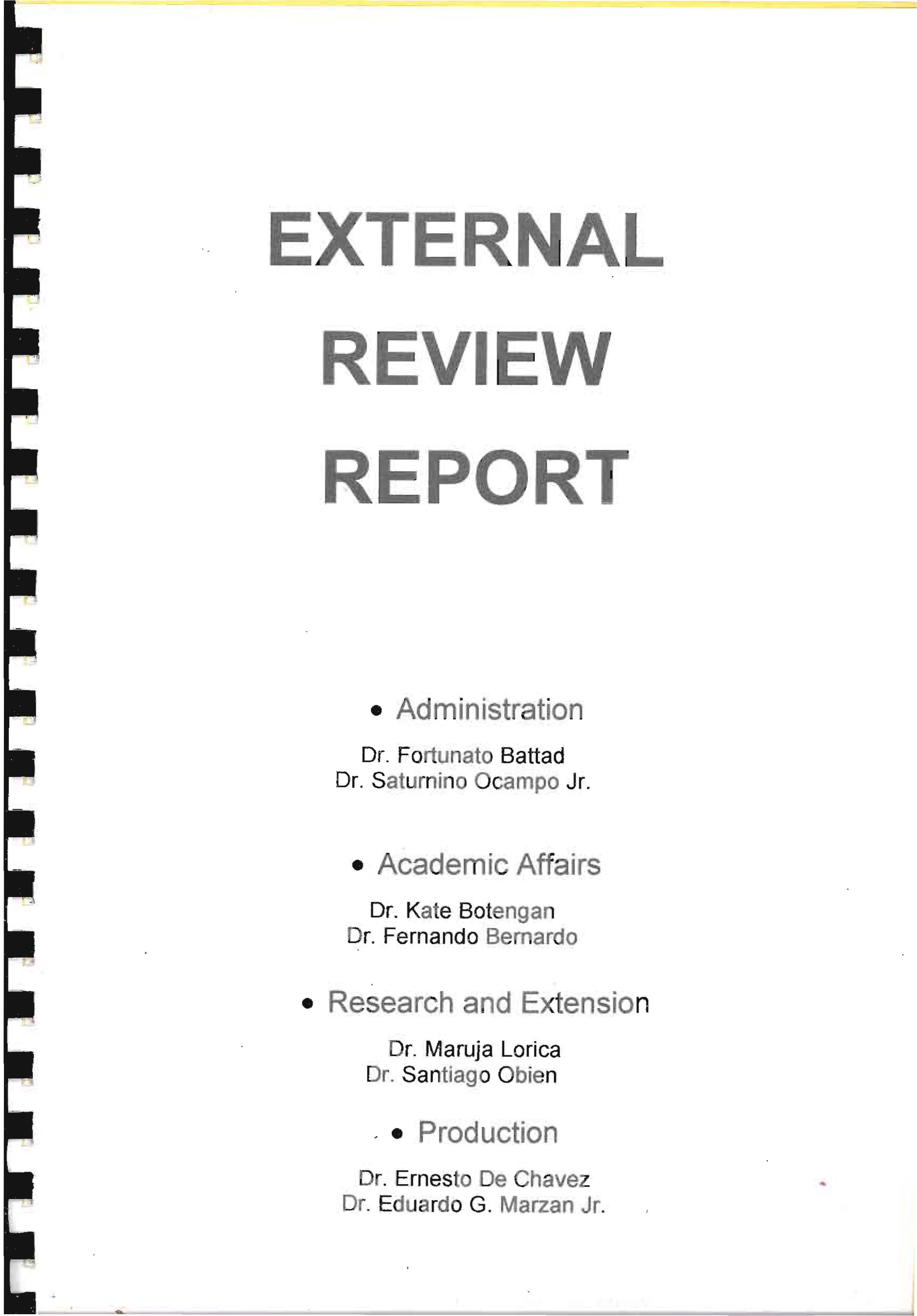
v
E
• Admin istr tion
Dr. F0 unat Battad
Dr. Sat rni
campo Jr.
• Aca e i A ai s
Dr. Ka e Bot nga
r. Fernando Be ar 0
• esea had
te sian
Dr. Maruja Lorica
r. Santiago Obi n
- • Production
Dr. Ernest
e h vez
Dr. E
rdo G. Marza Jr.
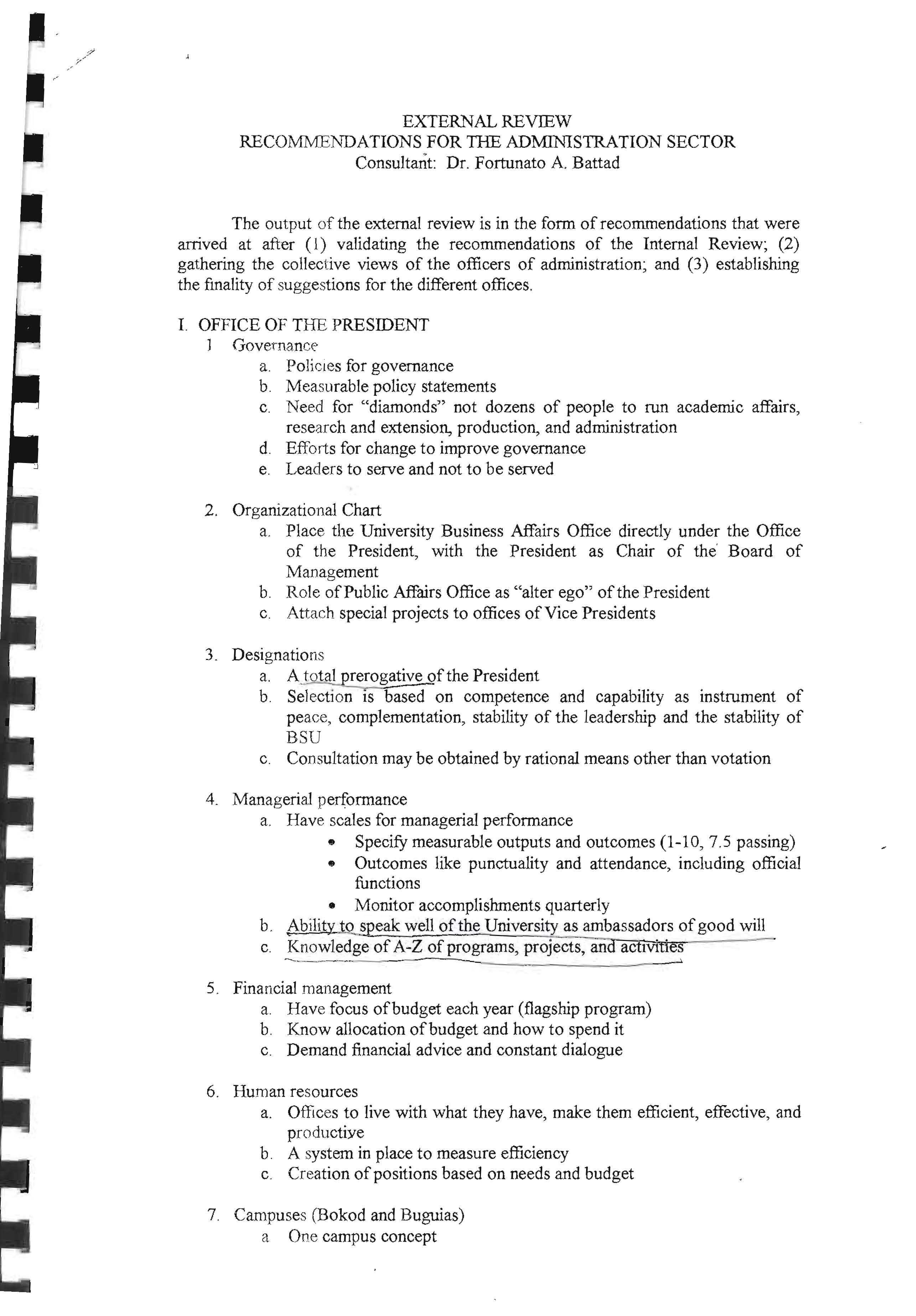
EXTERNAL REVIEW
RECOMMENDATIONS FOR TIlE ADMIN1STRATION SECTOR
Consultant: Dr. Fortunato A. Battad
The output of the external review is in the fonn of recommendations that were
arrived at after (1) validating the recommendations of the Internal Review; (2)
gathering the collective views of the officers of administration; and (3) establishing
the fmaIity of suggestions for the different offices.
I. OFFICE OF Th"t PRESIDENT
]
Govemanc~
a. Policies for governance
b. Measurable policy statements
c. Need for "diamonds" not dozens of people to run academic affairs,
research and extension, production, and administration
d. Efforts for change to improve governance
e. Leaders to serve and not to be served
2. Organizational Chart
a. Place the University Business Affairs Office directly under the Office
of the President, with the President as Chair of the' Board of
Management
b. Role of Public Affairs Office as "alter ego" of the President
c. Attach special projects to offices of Vice Presidents
3. Designations
a. A. total rerog~e-9fthe President
b. Selection is based on competence and capability as instrument of
peace, complementation, stability of the leadership and the stability of
BSU
c. Consultation may be obtained by rational means other than votation
4. Manageria.l perfonnance
a. Have scales for managerial perfonnance
• Specify measurable outputs and outcomes (1-10, 7.5 passing)
• Outcomes like punctuality and attendance, including official
functions
• Monitor accomplishments quarterly
b. f\\bility: 19.2Eeak well of the University as ambassadors of good will
c. Knowledge of A-Z of programs, projects, an ac lvi . S
5. Financial management
a. Have focus of budget each year (flagship program)
b. Know allocation of budget and how to spend it
c. Demand financial advice and constant dialogue
6. Human resources
a. Offices to live with what they have, make them efficient, effective, and
productiYe
b. A system in place to measure efficiency
c. Creation of positions based on needs and budget
7. Campuses (Bokod and Buguias)
a One campus concept
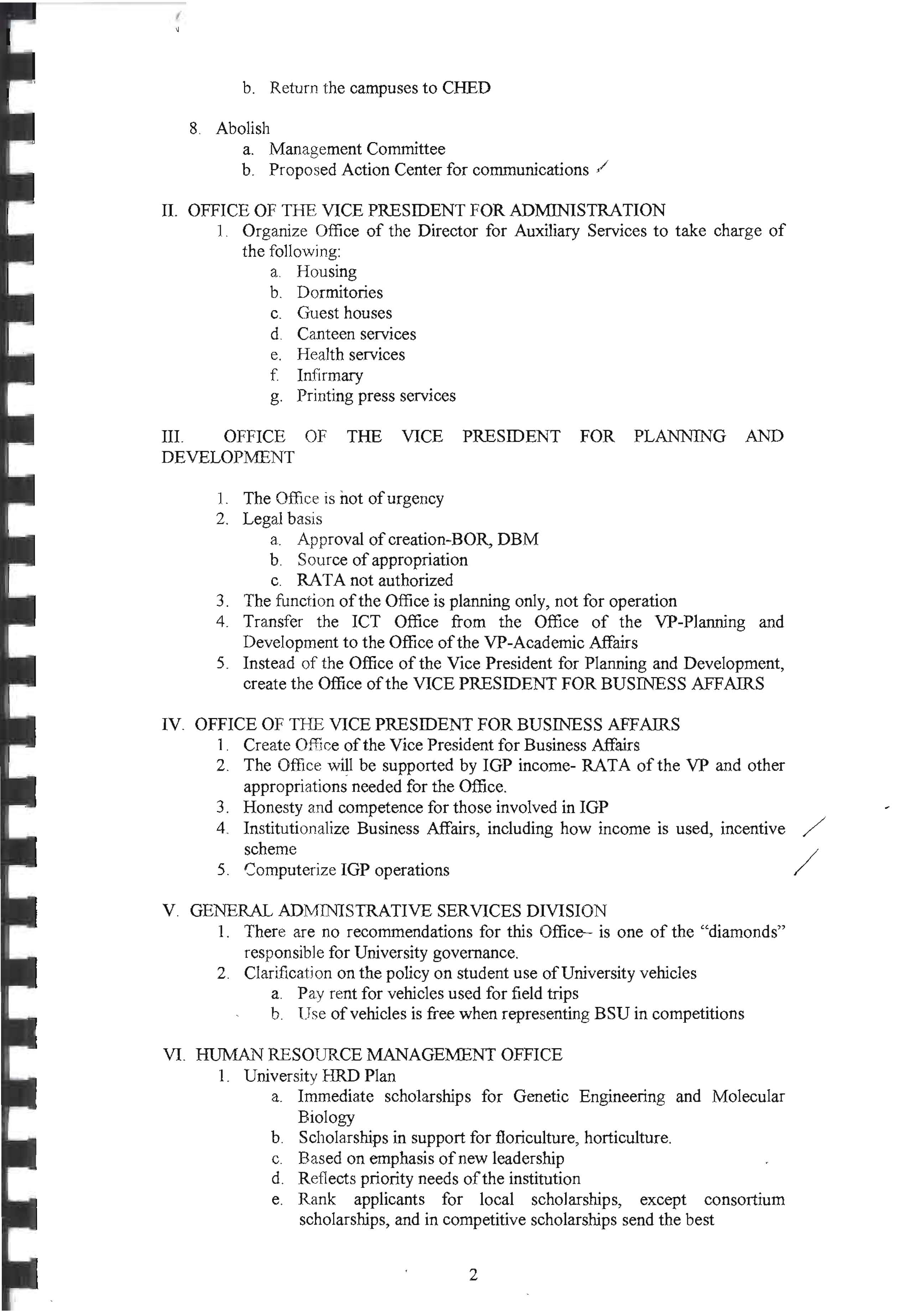
b. Return the campuses to CHED
8. Abolish
a. Management Committee
b. Proposed Action Center for communications ,/
II. OFFICE OF THE VICE PRESIDENT FOR ADMINISTRATION
1. Organize Office of the Director for Auxiliary Services to take charge of
the following:
a. Housing
b. Dormitories
c. Guest houses
d. Canteen services
e. Health services
f
Infirmary
g. Printing press services
III.
OFFICE OF
THE VICE PRESIDENT FOR PLANNING AND
DEVELOPMENT
1. The Office is not of urgency
2. Legal basis
a. Approval of creation-BOR, DBM
b. Source of appropriation
c. RATA not authorized
3. The function of the Office is planning only, not for operation
4. Transfer the ICT Office from the Office of the VP-Planning and
Development to the Office of the VP-Academic Affairs
5. Instead of the Office of the Vice President for Planning and Development,
create the Office of the VICE PRESIDENT FOR BUSINESS AFFAIRS
IV. OFFICE OF THE VICE PRESIDENT FOR BUSINESS AFFAIRS
1. Create Office ofthe Vice President for Business Affairs
2. The Office will be supported by IGP income- RATA of the VP and other
appropriations needed for the Office.
3. Honesty and competence for those involved in IGP
4. Institutionalize Business Affairs, including how income is used, incentive /
scheme
5. Computerize IGP operations
/
V. GENERAL ADMINISTRATIVE SERVICES DIVISION
1. There are no recommendations for this Office- is one of the "diamonds"
responsible for University governance.
2. Clarification on the policy on student use of University vehicles
a. Pay rent for vehicles used for field trips
b. Use of vehicles is free when representing BSU in competitions
VI. HUMAN RESOURCE MANAGEMENT OFFICE
1. University HRD Plan
a. Immediate scholarships for Genetic Engineering and Molecular
Biology
b. Scholarships in support for floriculture, horticulture.
c. Based on emphasis of new leadership
d. Reflects priority needs ofthe institution
e. Rank applicants for local scholarships, except consortium
scholarships, and in competitive scholarships send the best
2
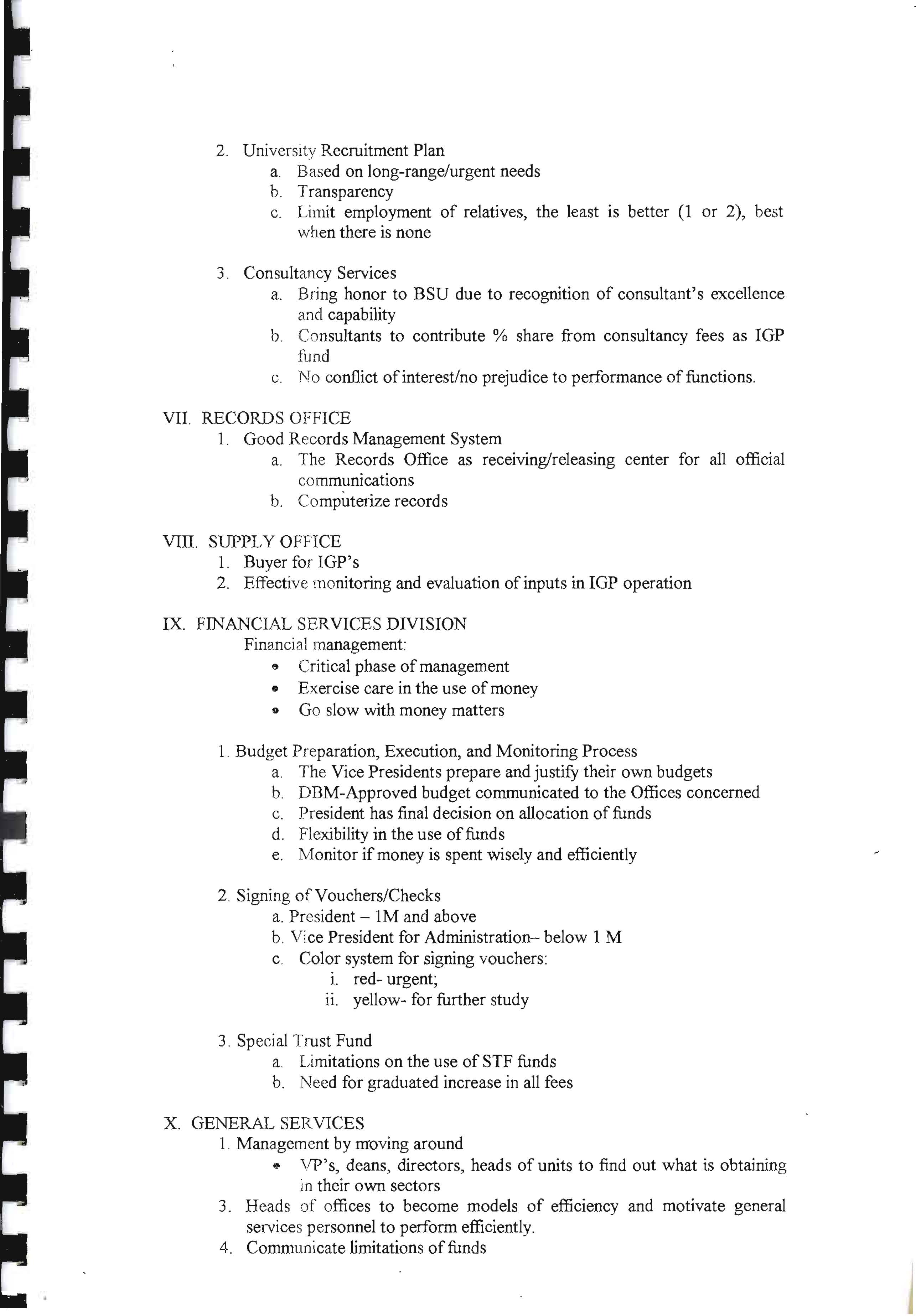
2. University Recruitment Plan
a. Based on long-range/urgent needs
b. Transparency
c. Limit employment of relatives, the least is better (1 or 2), best
when there is none
3. Consultancy Services
a. Bring honor to BSU due to recognition of consultant's excellence
and capability
b. Consultants to contribute % share from consultancy fees as IGP
tlJnd
c. No conflict of interest/no prejudice to performance of functions.
VII. RECORDS OFFICE
1. Good Records Management System
a. The Records Office as receiving/releasing center for all official
communications
b. Computerize records
VIII. SUPPLY OFFICE
1. Buyer for IGP's
2. Effective monitoring and evaluation of inputs in IGP operation
IX. FINANCIAL SERVICES DIVISION
Financial management
e
Critical phase of management
• Exercise care in the use of money
o
Go slow with money matters
1. Budget Preparation, Execution, and Monitoring Process
a. The Vice Presidents prepare and justify their own budgets
b. DBM-Approved budget communicated to the Offices concerned
c. President has final decision on allocation of funds
d. Flexibility in the use offunds
e. Monitor if money is spent wisely and efficiently
2. Signing of Vouchers/Checks
a. President - 1M and above
b. Vice President for Administration- below 1 M
c. Color system for signing vouchers:
i. red- urgent;
ii. yellow- for further study
3. Special Trust Fund
a. Llmitations on the use of STF funds
b. Need for graduated increase in all fees
X. GENERAL SERVICES
1. Management by moving around
eo
\\lP's, deans, directors, heads of units to find out what is obtaining
in their own sectors
3. Heads of offices to become models of efficiency and motivate general
services personnel to perform efficiently.
4. Communicate limitations offunds
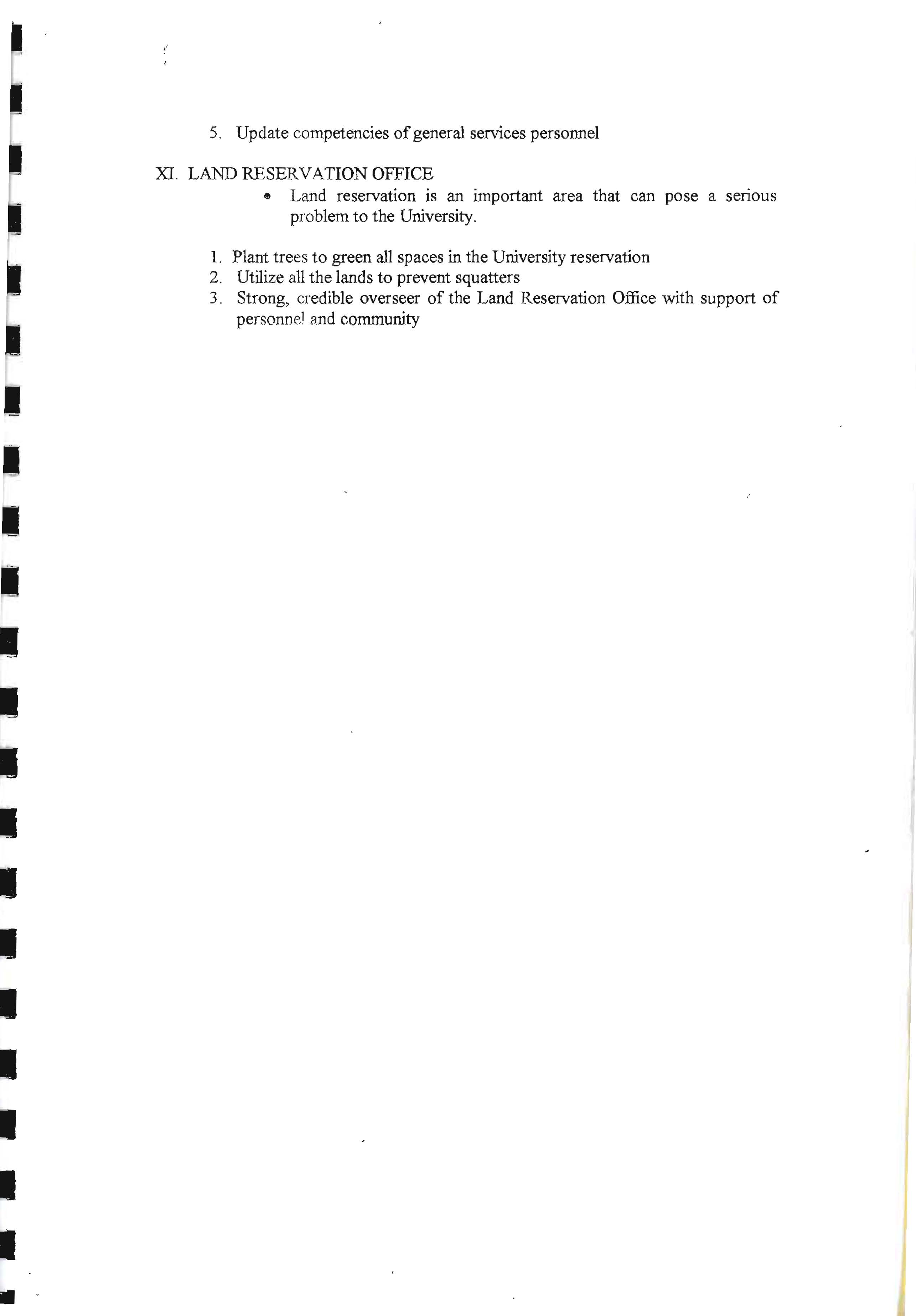
5. Update competencies of general services personnel
XI. LAND RESERVATION OFFICE
• Land reservation is an important area that can pose a senous
problem to the University.
1. Plant trees to green all spaces in the University reservation
2. Utilize all the lands to prevent squatters
3. Strong, credible overseer of the Land Reservation Office with support of
1
d
.
personne, an comm.umty
I
I
I
I
I
I
I
I
I
I
•
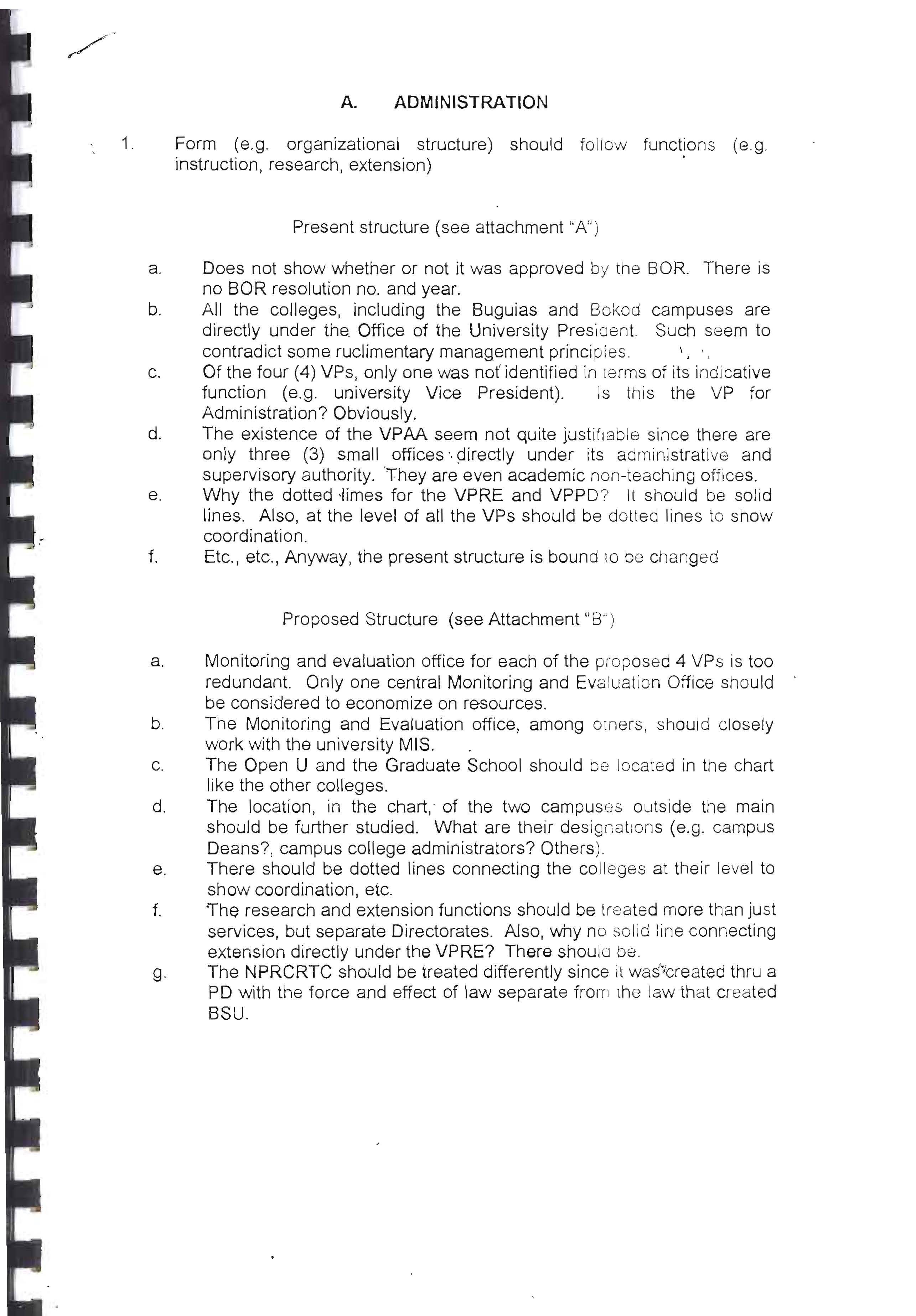
, /
A.
ADMiNISTRATION
1.
Form (e.g. organizational structure) should follow functions (e.g.
instruction, research, extension)
Present structure (see attachment "A")
a.
Does not show whether or not it was approved by the BOR There is
no BOR resolution no. and year.
b.
All the colleges, including the Buguias and Bokod campuses are
directly under the. Office of the University Presiaent. Such seem to
contradict some rudimentary management principies.
\\ ,
c.
Of the four (4) VPs, only one was not' identified in terms of its indicative
function (e.g. university Vice President).
Is this the VP for
Administration? Obviously.
d.
The existence of the VPAA seem not quite justifiable since there are
only three (3) small offices'· qirectly under its administrative and
supervisory authority. 'They are even academic non-teaching offices.
e.
Why the dotted -limes for the VPRE and VPPD? It should be solid
lines. Also, at the level of atl the VPs should be dotted lines to show
coordination.
f.
Etc., etc., Anyway, the present structure is bound to be changed
Proposed Structure (see Attachment" 8")
a.
Monitoring and evaluation office for each of the proposed 4 VPs is too
redundant. Only one central Monitoring and Evaluation Office should
be considered to economize on resources.
b.
The Monitoring and Evaluation office, among olners, should closely
work with the university MIS.
c.
The Open U and the Graduate School should be located in the chart
like the other colleges.
d.
The location, in the chart,' of the two campuses outside the main
should be further studied. What are their designations (e.g. campus
Deans?, campus college administrators? Others).
e.
There should be dotted lines connecting the colleges at their level to
show coordination, etc.
f.
'The research and extension functions should be treated more than just
services, but separate Directorates. Also, why no solid line connecting
extension directly under the VPRE? There shoulu be.
g.
The NPRCRTC should be treated differently since it wasN:created thru a
PO with the force and effect of law separate from the law that created
BSU.
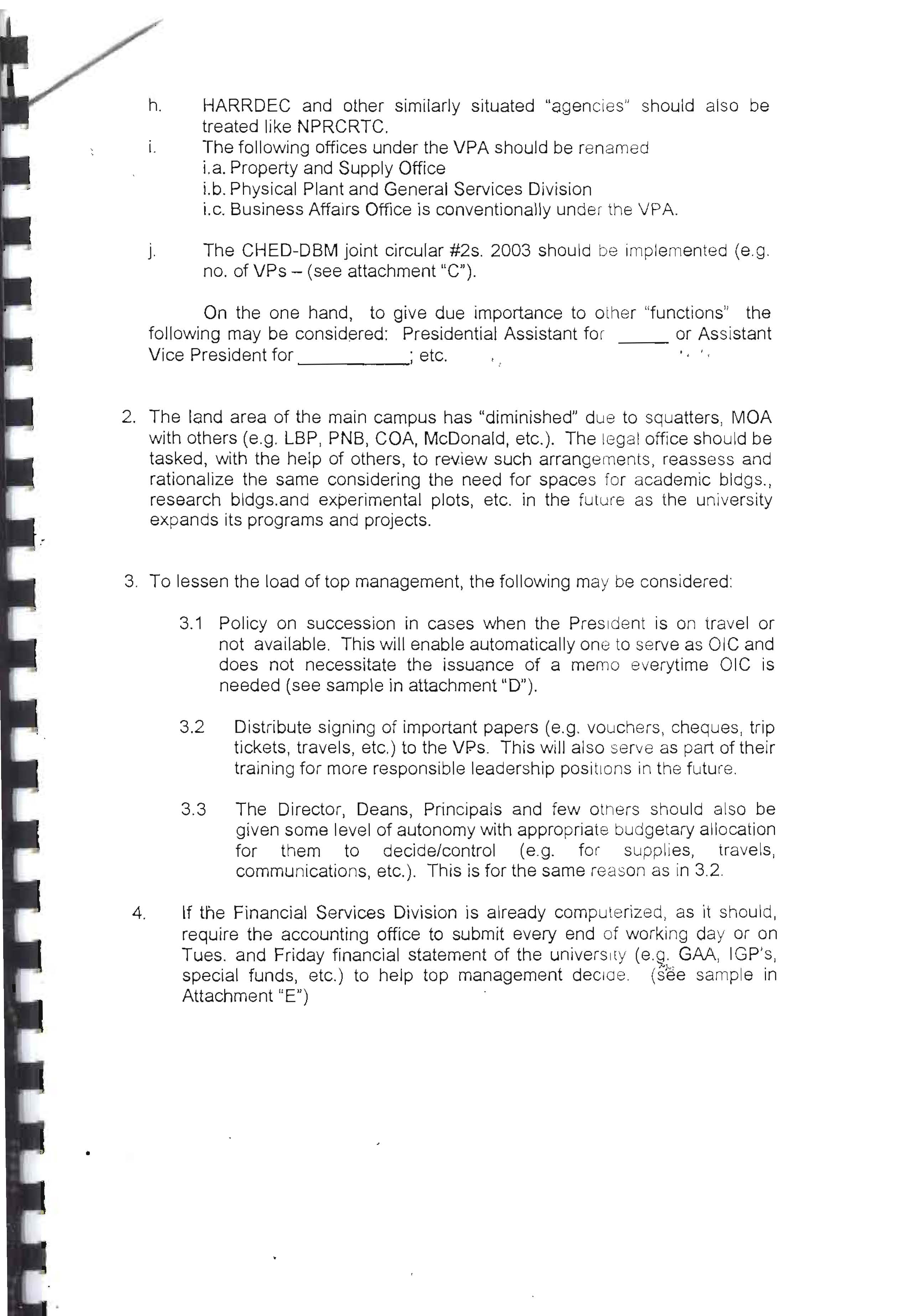
h.
HARRDEC and other similarly situated "agencies" should also be
treated like NPRCRTC.
i.
The following offices under the VPA should be renamed
i.a. Property and Supply Office
Lb. Physical Plant and General Services Division
i.c. Business Affairs Office is conventionally under the VPA.
J.
The CHED-DBM joint circular #2s. 2003 should be implemented (e.g.
no. of VPs - (see attachment "C").
On the one hand, to give due importance to other "functions" the
following may be considered: Presidential Assistant for
or Assistant
Vice President for
; etc.
'. "
2, The land area of the main campus has "diminished" due to squatters, MOA
with others (e.g. LBP, PNB, COA, McDonald, etc.). The legal office should be
tasked, with the help of others, to review such arrangements, reassess and
rationalize the same considering the need for spaces for academic bldgs.,
research bldgs.and experimental plots, etc. in the future as the university
expands its programs and projects.
3. To lessen the load of top management, the following may be considered:
3.1 Policy on succession in cases when the President is on travel or
not available. This will enable automatically one to serve as OIC and
does not necessitate the issuance of a memo everytime OIC is
needed (see sample in attachment "0").
3.2
Distribute signing of important papers (e.g. vouchers, cheques, trip
tickets, travels, etc.) to the VPs. This will also serve as part of their
training for more responsible leadership positions in the future.
3.3
The Director, Deans, Principals and few otners should also be
given some level of autonomy with appropriate budgetary allocation
for
them
to
decide/control
(e.g.
for
supplies,
travels,
communications, etc.). This is for the same reason as in 3.2.
4.
If tne Financial Services Division is already computerized, as it should,
require the accounting office to submit every end of working day or on
Tues. and Friday financial statement of the university (e.g: GAA, IGP's,
special funds, etc.) to help top management decloe.
(see sample in
Attachment "E")
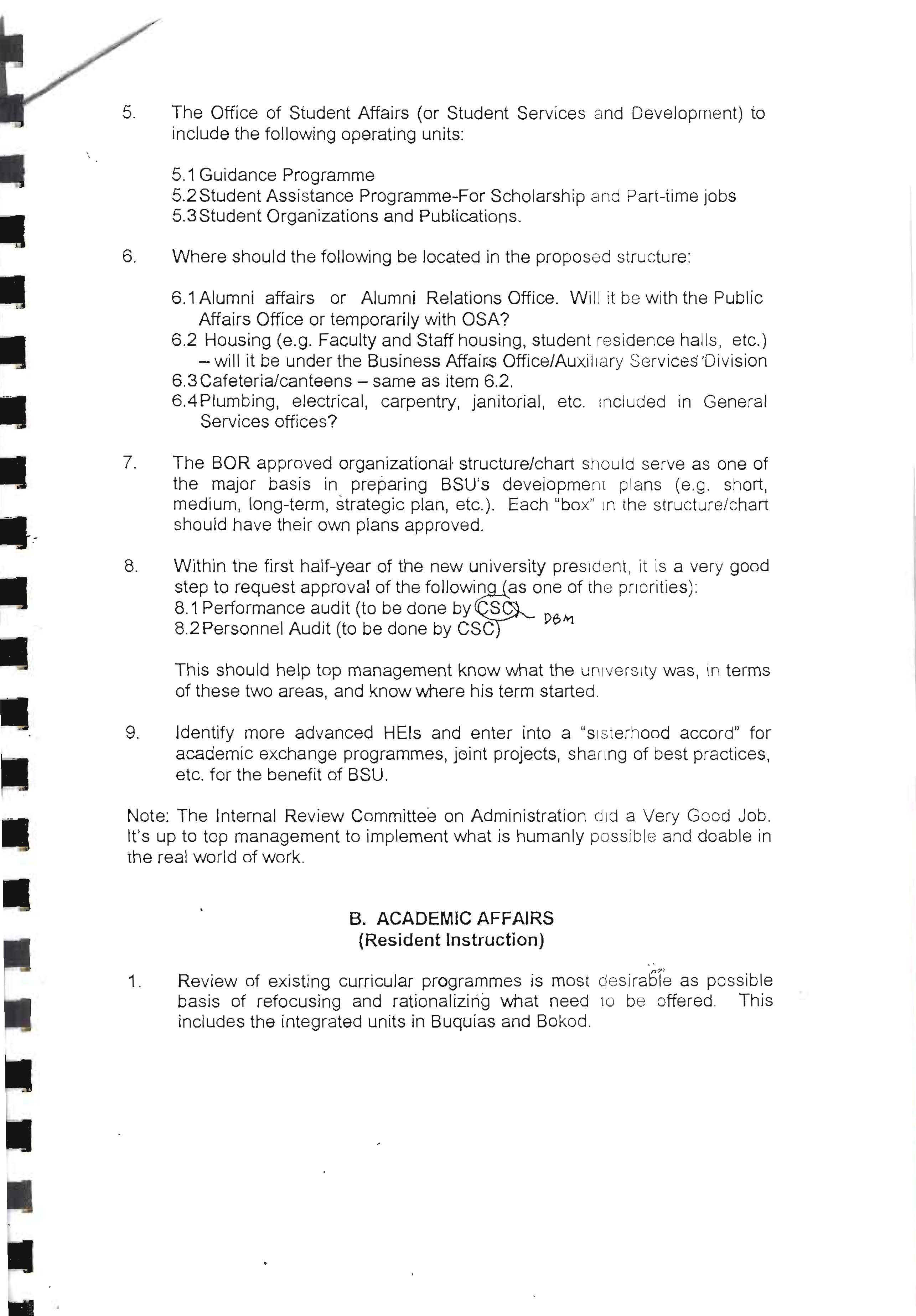
The Office of Student Affairs (or Student Services and Development) to
include the following operating units:
5.1 Guidance Programme
5.2Student Assistance Programme-For Scholarship and Part-time jobs
5.3Student Organizations and PubHcations.
6.
Where should the following be located in the proposed structure:
6.1 Alumni affairs or Alumni Relations Office. Will it be with the Public
Affairs Office or temporarily with OSA?
6.2 Housing (e.g. Faculty and Staff housing, student residence halls, etc.)
- will it be under the Business Affair<s Office/Auxiliary Services 'Division
6.3 Cafeteria/canteens - same as item 6.2.
6.4Plumbing, electrical, carpentry, janitorial, etc. included in General
Services offices?
• 7. The BaR approved organizational' structure/chart should serve as one of
the major basis in preparing BSU's developmem plans (e.g. short,
medium, long-term, strategic plan, etc.). Each "box" In the structure/chart
•••
should have their own plans approved.
8.
Within the first half-year of the new university president, it is a very good
step to request approval of the fOllowi~asone of the priorities):
8.1 Performance audit (to be done by S
Pe>
8.2 Personnel Audit (to be done by esc
iI1
This should help top management know what the university was, In terms
of these two areas, and know Vv'here his term started.
9.
Identify more advanced HEls and enter into a "sisterhood accord" for
academic exchange programmes, joint projects, sharing of best practices,
etc. for the benefit of BSU.
Note: The Internal Review Committee on Administration did a Very Good Job.
It's up to top management to implement what is humanly possible and doable in
the real world of work.
B. ACADEMIC AFFAIRS
(Resident Instruction)
{')">'~
1.
Review of existing curricular programmes is most desirable as possible
basis of refocusing and rationalizing Vv'hat need 10 be offered
This
includes the integrated units in Buquias and Bokod.
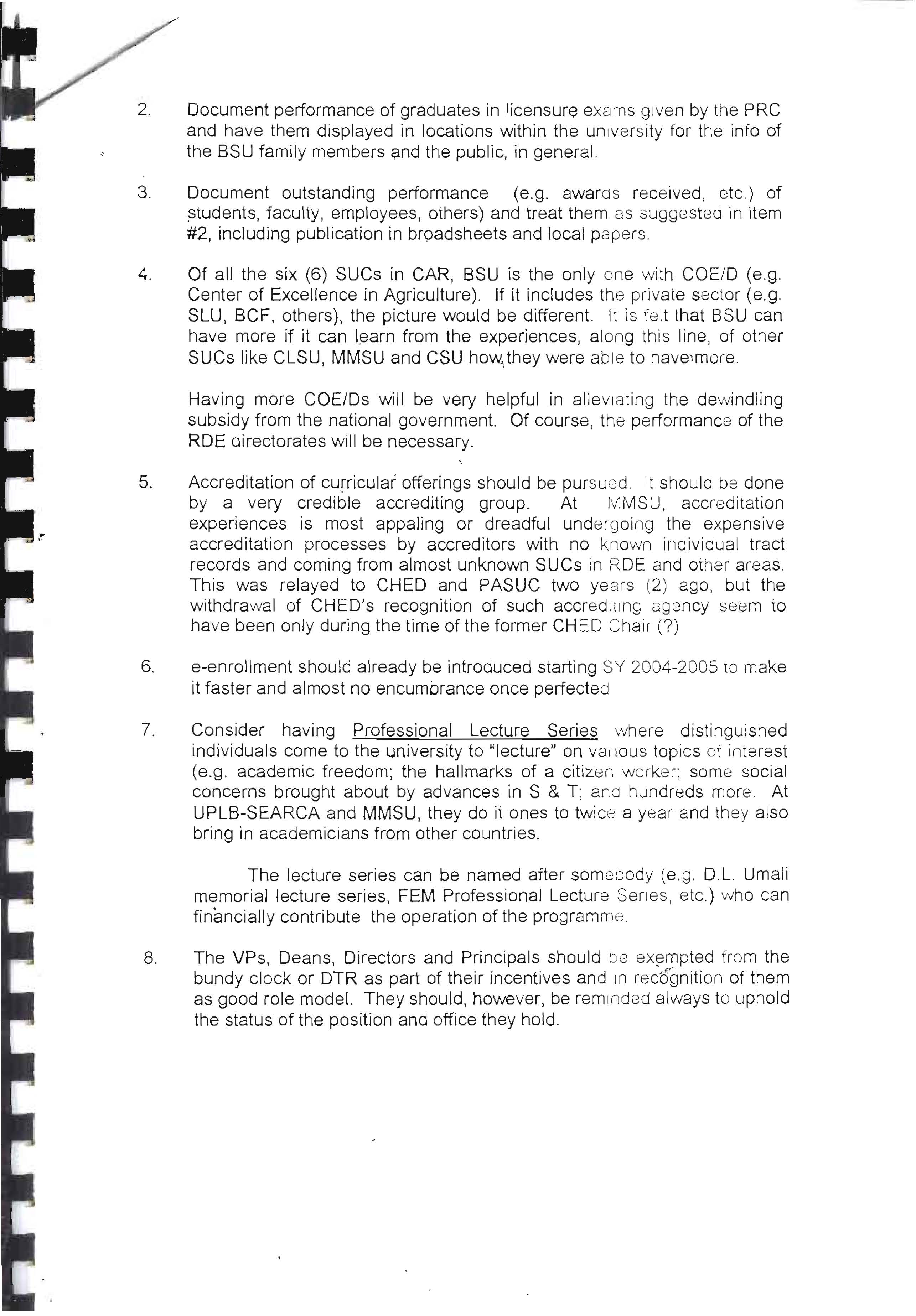
Document performance of graduates in licensure exams given by the PRC
and have them displayed in locations within the university for the info of
the BSU family members ~nd the public, in general.
Document outstanding performance
(e.g. awaras received, etc.) of
~tudents, faculty, employees, others) and treat them as suggested in item
#2, including publication in broadsheets and local papers.
Of all the six (6) SUCs in CAR, BSU is the only one with COEID (e.g.
Center of Excellence in Agriculture). If it includes the private sector (e.g.
SLU, BCF, others), the picture would be different. It is felt that BSU can
have more if it can I,earn from the experiences, along this line, of other
SUCs like CLSU. MMSU and CSU how/they were able to have1m~xe.
Having more CaE/Os will be very helpful in alleviating the dewindling
subsidy from the national government. Of course, the performance of the
ROE directorates will be necessary.
Accreditation of curricular offerings should be pursued. It should be done
by a very credible accrediting group.
At
JV1MSU, accreditation
experiences is most appaling or dreadful undergoing the expensive
accreditation processes by accreditors with no known individual tract
records and coming from almost unknown SUCs in ROE and other areas.
This was relayed to CHED and PASUC two yec1rs (2) ago, but the
withdrawal of CHEO's recognition of such accrediting agency seem to
have been only during the time of the former CHED Chair (?)
e-enrollment should already be introduced starting SY 2004-2005 to make
it faster and almost no encumbrance once perfected
Consider having Professional Lecture Series where distinguished
individuals come to the university to "lecture" on various topics of interest
(e.g. academic freedom; the hallmarks of a citiz.en worker; some social
concerns brought about by advances in S & T; and hundreds more. At
UPLB-SEARCA and MMSU, they do it ones to twice a year and they also
bring in academicians from other countries.
The lecture series can be named after somebody (e.g. D.L. Umali
memorial lecture series, FEM Professional Lecture Series, etc.) who can
financially contribute the operation of the programme.
The VPs, Deans, Directors and Principals should be ex~mpted from the
bundy clock or OTR as part of their incentives and In recbgnition of them
as good role model. They should, however, be reminded always to uphold
the status of the position and office they hold.
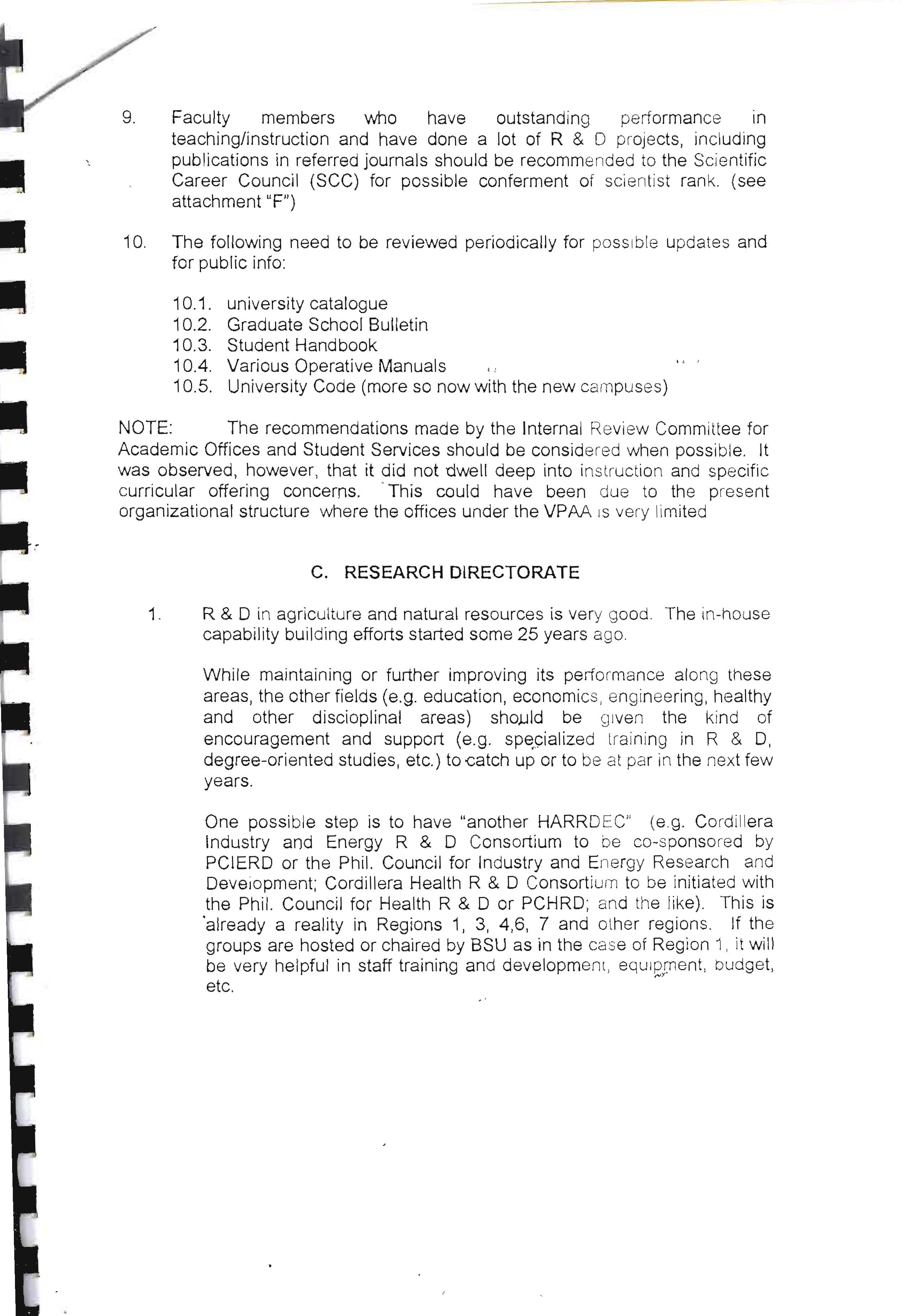
Faculty
members
who
have
outstanding
performance
In
•
teaching/instruction and have done a lot of R&D projects, including
pUblications in referred journals should be recommended to the Scientific
Career Council (SCC) for possible conferment of scientist rank. (see
attachment "F")
10.
The following need to be reviewed periodically for possible updates and
•
for pUblic info:
10.1. university catalogue
•
10.2. Graduate School Bulletin
10.3. Student Handbook
10.4. Various Operative Manuals
!,
•
10.5. University Code (more so now with the new campuses)
NOTE:
The recommendations made by the Internal ~~evjew Committee for
Academic Offices and Student Services should be considered when possible. It
was observed, however, that it did not dwell deep into instruction and specific
curricular offering concerns.
. This could have been due to the present
organizational structure where the offices under the VPAA IS very limited
C, RESEARCH DIRECTORATE
1.
R & 0 in agriculture and natural resources is very good. The in-house
capability building efforts started some 25 years ago.
While maintaining or further improving its performance along these
areas, the other fields (e.g. education, economics, engineering, healthy
and other discioplinal areas) shoJJld be given the kind of
encouragement and support (e.g. sp~yialized training in R & 0,
degree-oriented stUdies, etc.) to catch up or to be at par in the next few
years.
One possible step is to have "another HARROEC" (e.g. Cordillera
Industry and Energy R & 0 Consortium to be co-sponsored by
PCIERO or the Phil. Council for Industry and Energy Research and
Oeveiopment; Cordillera Health R & 0 Consortium to be initiated with
the Phil. Council for Health R & 0 or PCHRO; and the like). This is
'already a reality in Regions 1 3, 4,6, 7 and other regions. If the
J
groups are hosted or chaired by BSU as in the case of Region 1, it will
be very helpful in staff training and development, equl8fnent, budget,
etc.
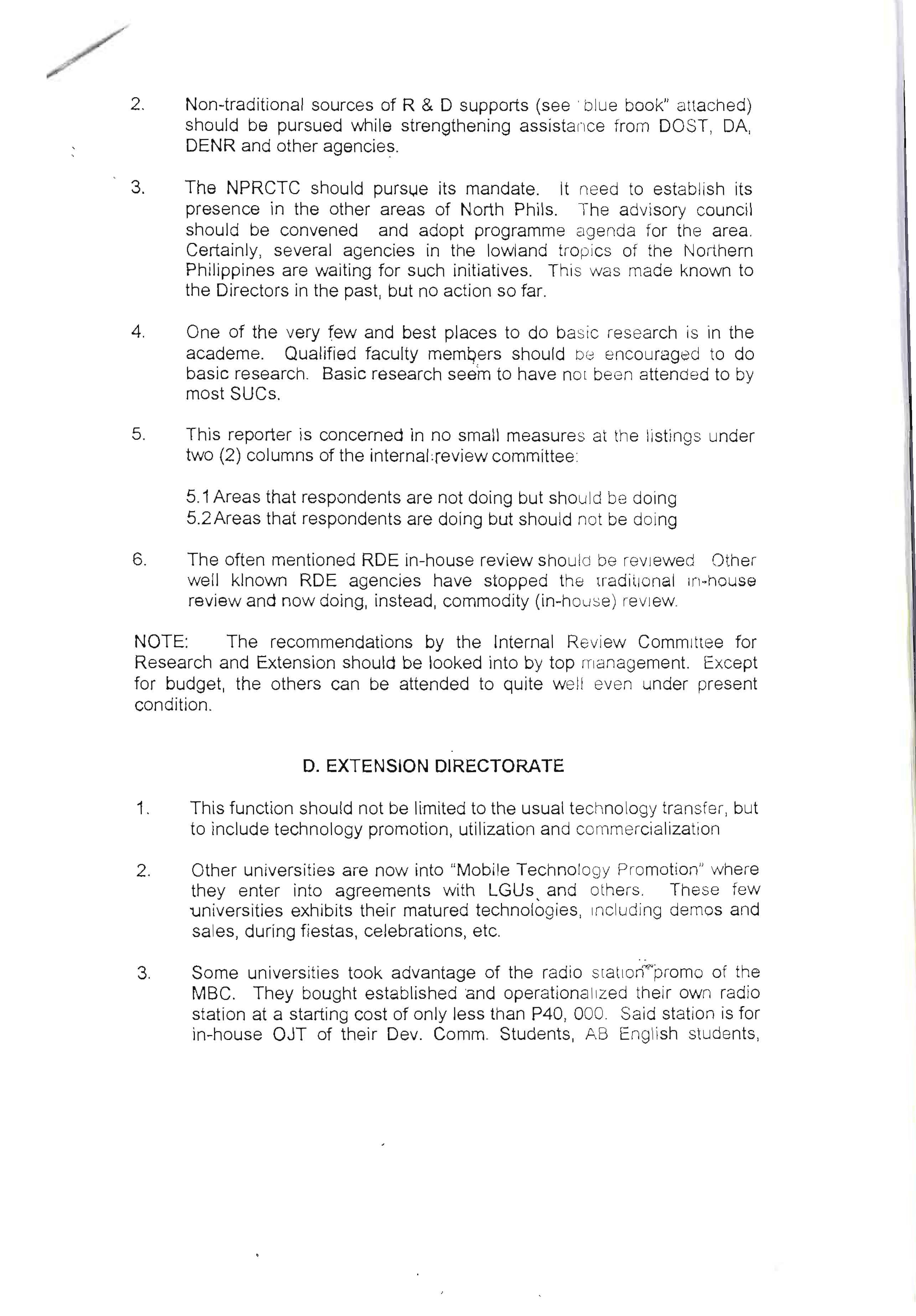
2.
Non-traditional sources of R&D supports (see' blue book" attached)
should be pursued while strengthening assistance from DOST, DA,
DENR and other agencies.
3.
The NPRCTC should pursl,Je its mandate. It need to establish its
presence in the other areas of N.orth Phi Is.
The advisory council
should be convened
and adopt programme agenda for the area.
Certainly, several agencies in the lowland tropics of the Northern
Philippines are waiting for such initiatives. This was made known to
the Directors in the past, but no action so far.
4.
One of the very few and best places to do basic research is in the
academe.
Qualified faculty memqers should b8 encouraged to do
basic research. Basic research see'm to have nOl been attended to by
most SUCs.
5.
This reporter is concerned in no small measures at the listings under
two (2) columns of the interna/:review committee
5.1 Areas that respondents are not doing but should be doing
5.2Areas that respondents are doing but should not be doing
6.
The often mentioned RDE in-house review should be reviewed Other
well klnown RDE agencies have stopped the lraditlonal In~house
review and now doing, instead, commodity (in-house) reView.
NOTE:
The recommendations by the Internal Review Committee for
Research and Extension should be looked into by top rnanagement. Except
for budget, the others can be attended to quite well even under present
condition.
D. EXTENSION DIRECTORATE
1.
This function should not be limited to the usual technology transfer, but
to include technology promotion, utilization and commercialization
2.
Other universities are now into "Mobile Technology Promotion" where
they enter into agreements with LGUs, and others.
These few
'Universities exhibits their matured technologies, Including demos and
sales, during fiestas, celebrations, etc.
"
3.
Some universities took advantage of the radio slatlon"""'promo of the
MBC. They bought established 'and operationallzed their own radio
station at a starting cost of only less than P40, 000. Said station is for
in-house OJT of their Dev. Comm. Students, AB English students,
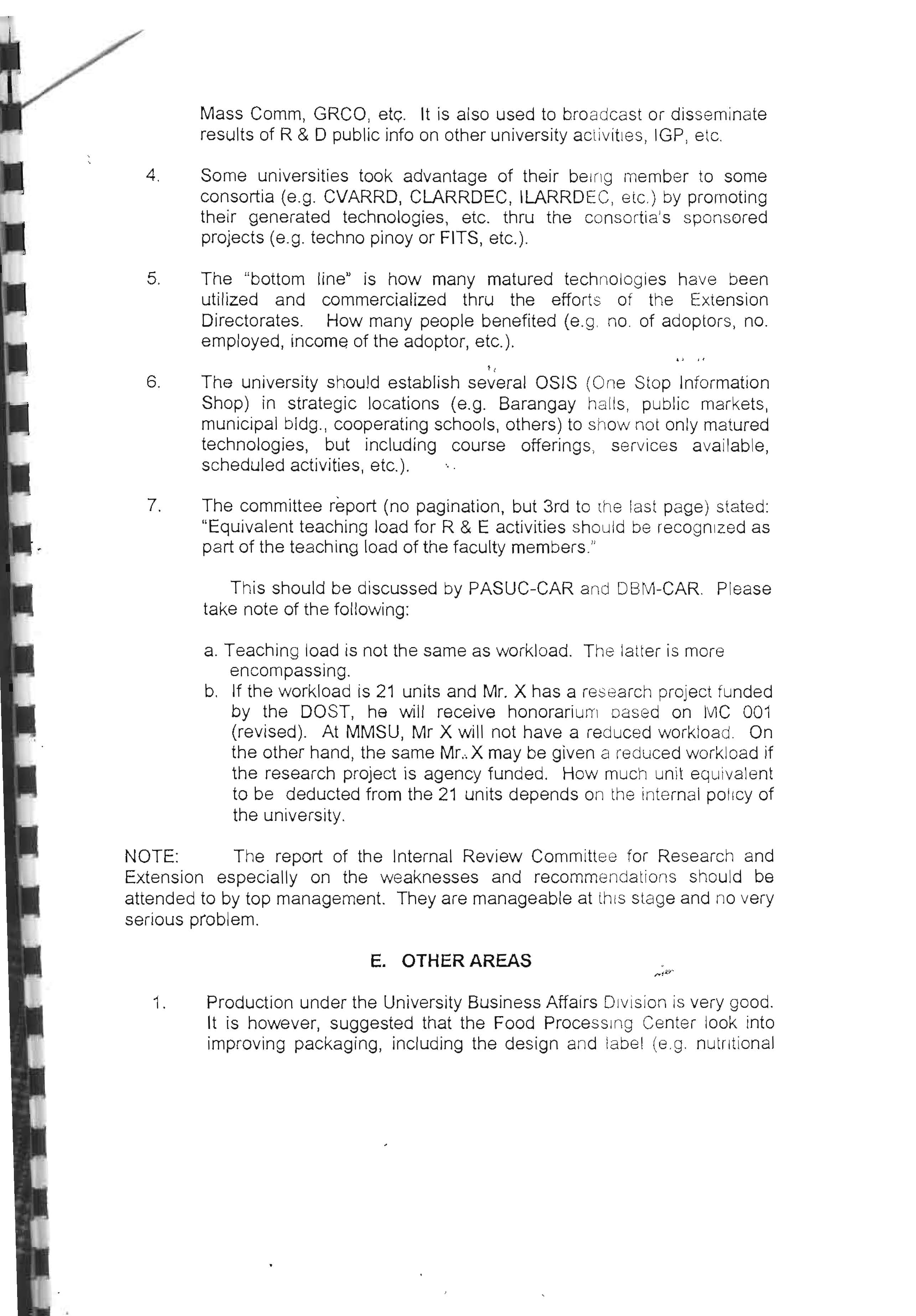
Mass Comm, GRCO, et<;. It is also used to broadcast or disseminate
results of R&D public info on other university activities, IGP, etc.
4.
Some universities took advantage of their being rnember to some
consortia (e.g. CVARRD, CLARRDEC, ILARRDEC, etc.) by promoting
their generated technologies, etc. thru the consortia's sponsored
projects (e.g. techno pinoy or FITS, etc.).
5.
The "bottom lineu is how many matured technologies have been
utilized and commercialized thru the efforts of the Extension
Directorates.
How many people benefited (e.g no. of adoptors, no.
employed, income of the adoptor, etc.).
"
6.
The university should establish several OSIS (One Stop Information
Shop) in strategic locations (e.g. Barangay halls, pUblic markets,
municipal bldg., cooperating schools, others) to show not only matured
technologies, but including course offerings, services available,
scheduled activities, etc.).
7.
The committee report (no pagination, but 3rd to the last page) stated:
"Equivalent teaching load for R & E activities should be recognized as
part of the teaching load of the faculty members."
This should be discussed by PASUC-CAR and DBM-CAR. Please
take note of the following:
a. Teaching load is not the same as workload. The latter is more
encompassing.
b. If the workload is 21 units and Mr. X has a research project funded
by the DOST, he will receive honorarium oased on MC 001
(revised). At MMSU, Mr X will not have a reduced workload. On
the other hand, the same Mr"X may be given a reduced workload if
the research project is agency funded, How much unit equivalent
to be deducted from the 21 units depends on the internal poliCy of
the university.
NOTE:
The report of the Internal Review Committee for Research and
Extension especially on the weaknesses and recommendations should be
attended to by top management. They are manageable at [his stage and no very
serious problem.
E. OTHER AREAS
1,
Production under the University Business Affairs Division is very good.
It is however, suggested that the Food Processing Center look into
improving packaging, including the design and label (e.g. nutritional
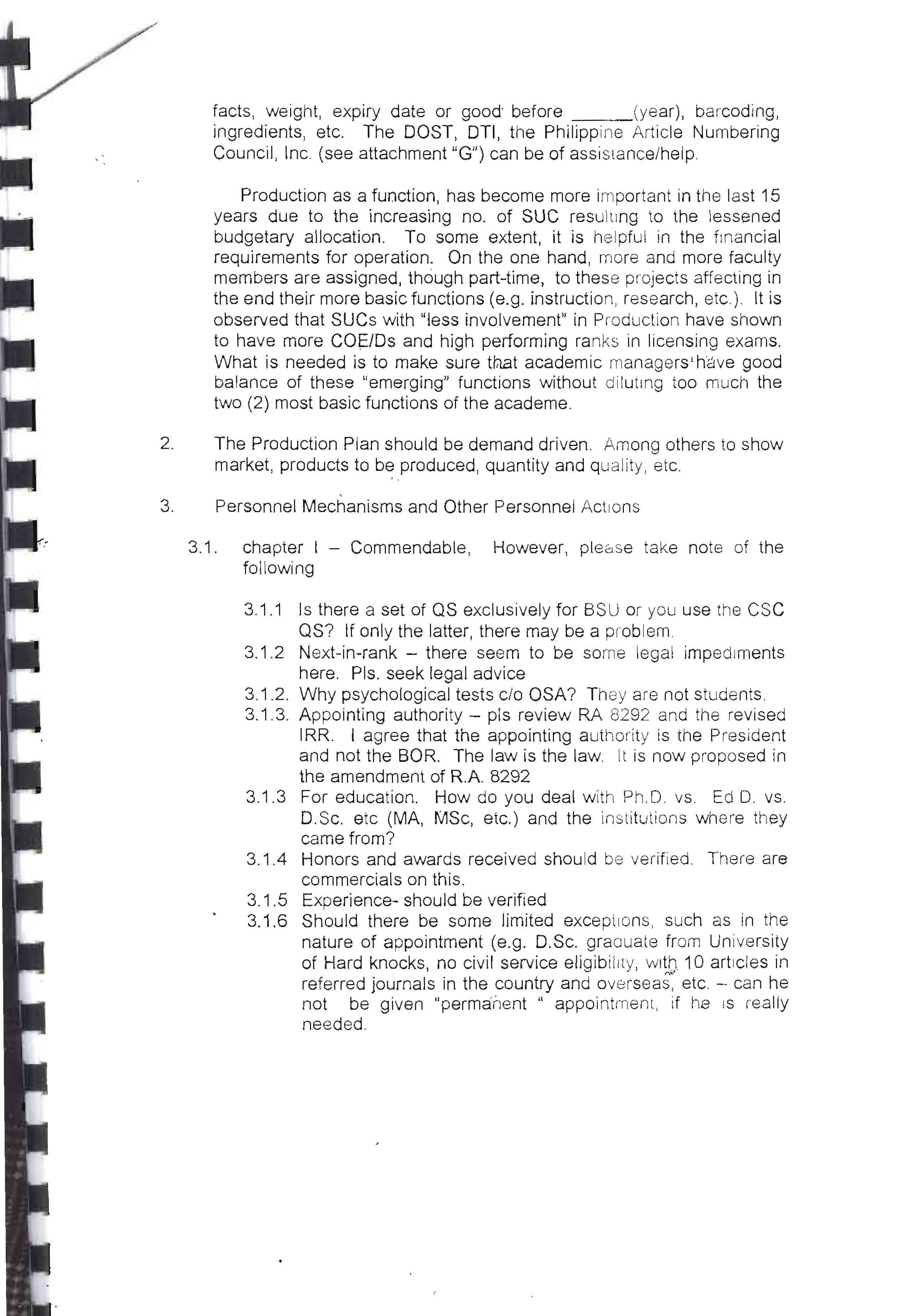
facts, weight, expiry date or good' before
(year), barcoding,
ingredients, etc. The DOST, DTI, the Philippine Article Numbering
Council, Inc. (see attachment "Gil) can be of assistance/help.
Production as a function, has become more important in the last 15
years due to the increasing no. of SUC resulting to the lessened
bUdgetary allocation. To some extent, it is helpful in the financial
requirements for operation. On the one hand, more and more faculty
members are assigned, though part-time, to these pcojects affecting in
the end their more basic functions (e.g. instruction, research, etc.). It is
observed that SUCs with "less involvement" in Production have shown
to have more COE/Ds and high performing ranks in licensing exams.
What is needed is to make sure that academic managers! h'8ve good
balance of these "emerging" functions without diluting too much the
two (2) most basic functions of the academe.
2.
The Production Plan should be demand driven. Among others to show
market, products to be produced, quantity and quality, etc.
. ,
3.
Personnel Mechanisms and Other Personnel Actions
3.1.
chapter I - Commendable,
However, pleGse take note of the
following
3.1.1 Is there a set of OS exclusively for BSU or you use the esc
OS? If only the latter, there may be a pwblem,
3.1.2 Next-in-rank - there seem to be some legal impediments
here. Pis. seek legal advice
3.1.2. Why psychological tests c/o OSA? They are not students.
3.1.3. Appointing authority - pis review RA 8292 and the revised
IRR. I agree that the appointing authority is the President
and not the BOR. The law is the law. It is now proposed in
the amendment of R.A. 8292
3.1.3 For education. How do you deal with Ph. D. VS. Ed D. vs.
D.Sc. etc (MA, MSc, etc.) and the institutions where they
came from?
3.1.4 Honors and awards received should be verified. There are
commercials on this.
3.1.5 Experience- should be verified
3.1.6 Should there be some limited exceptions, such as in the
nature of appointment (e.g. D.Sc. graauate from University
of Hard knocks, no civil service eligibility, w'~. 10 articles in
referred journals in the country and overseas, etc. - can he
not
be given "permanent " appointment, if he IS really
needed.
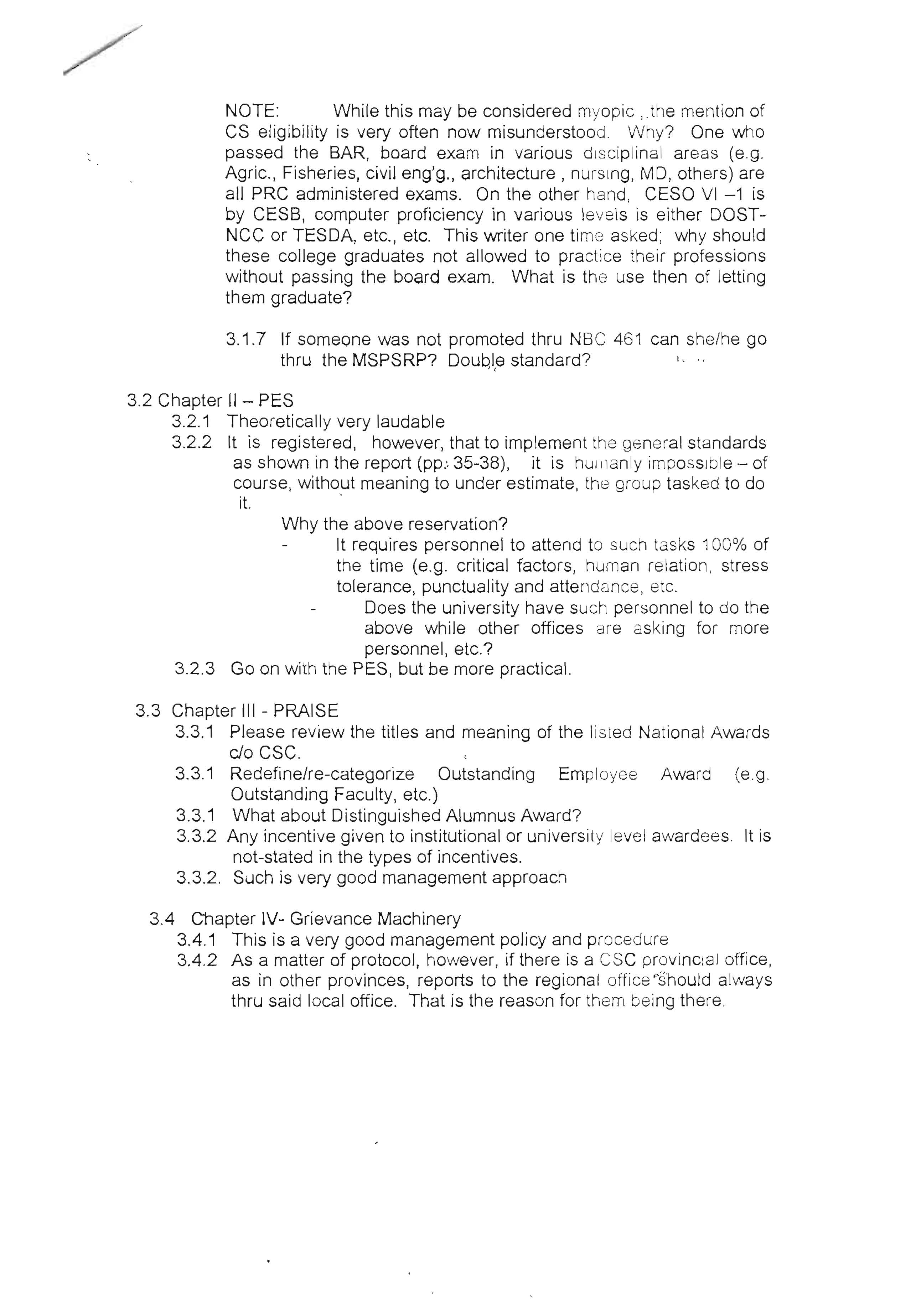
NOTE:
While this may be considered myopic ,. the mention of
CS eligibility is very often now misunderstood. Why? One who
passed the BAR, board exam in various dlsciplinal areas (e.g.
Agric., Fisheries, civil eng'g., architecture, nursing, MO, others) are
all PRC administered exams. On the other hand, CESO VI -1 is
by CESS, computer proficiency in various levels is either DOST
NCC or TESDA, etc., etc. This writer one time asked; why should
these college graduates not allowed to practice their professions
without passing the board exam. What is the use then of letting
them graduate?
3.1.7 If someone was not promoted thru NBC 461 can she/he go
thru the MSPSRP? Double standard?
t,
"
"
3.2 Chapter II - PES
3.2.1 Theoretically very laudable
3.2.2 It is registered, however, that to implement the genera! standards
as shovvn in the report (pp:. 35-38),
it is hUI11anly impoSSible - of
course, without meaning to under estimate, the group tasked to do
it.
.
Why the above reservation?
It requires personnel to attend to such tasks 100% of
the time (e.g. critical factors, human relation, stress
tolerance, punctuality and attendcJnce, etc.
Does the university have such personnel to do the
above while other offices are asking for more
personnel, etc.?
3.2.3 Go on with the PES, but be more practical.
3.3 Chapter III - PRAISE
3.3.1 Please review the Wles and meaning of the listed National Awards
clo CSC.
3.3.1 Redefine/re-categorize
Outstanding
Employee
Award
(e.g.
Outstanding Faculty, etc.)
3.3.1 What about Distinguished Alumnus Award?
3.3.2 Any incentive given to institutional or university level awardees. It is
not-stated in the types of incentives.
3.3.2. SLlch is very good management approach
3.4 Chapter IV- Grievance Machinery
3.4.1 This is a very good management policy and procedure
3.4.2 As a matter of protocol, however, if there is a esc provincial office,
as in other provinces, reports to the regional office "s'hould always
thru said local office. That is the reason for them being there,
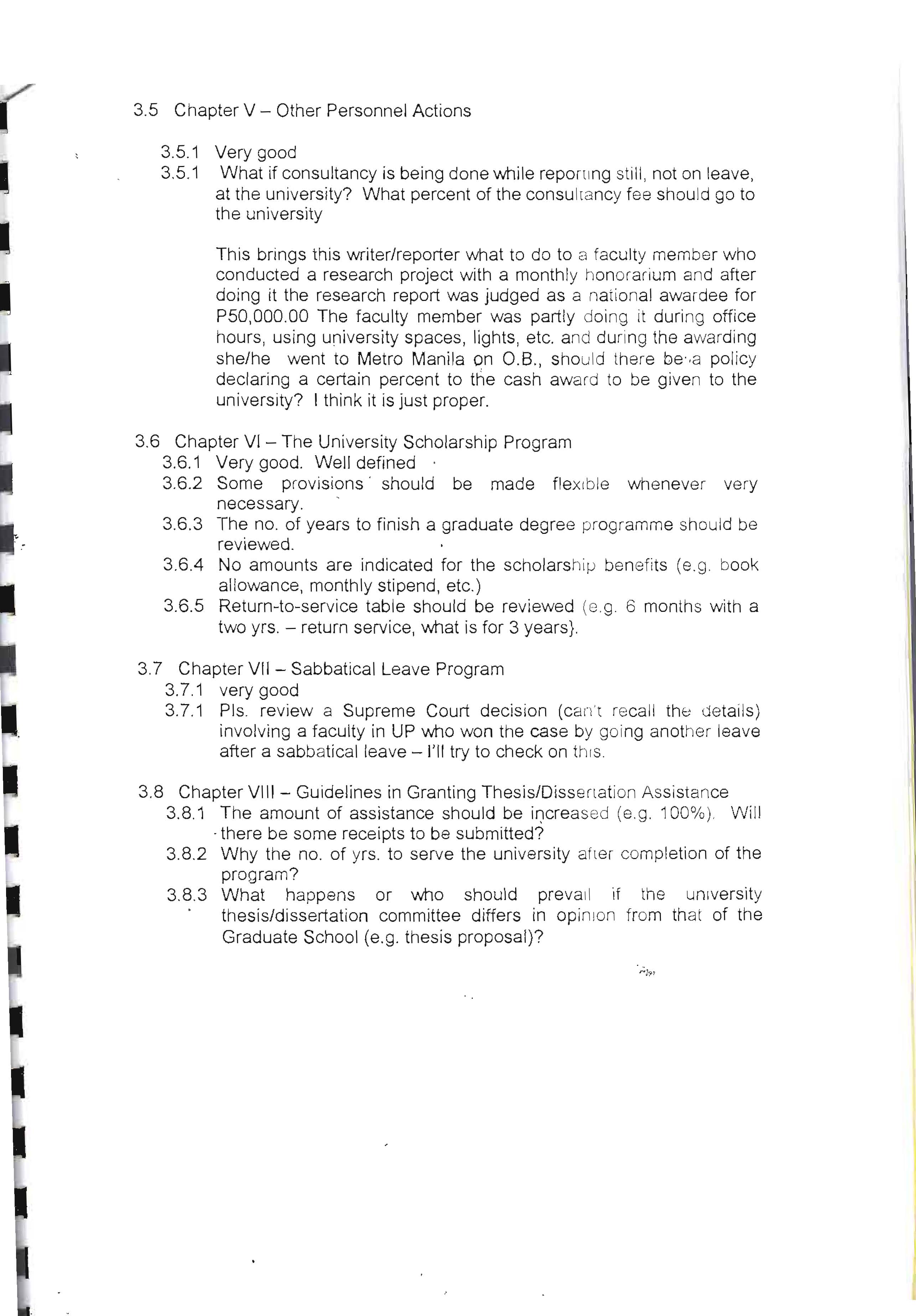
3.5 Chapter V - Other Personnel Actions
3.5.1 Very good
I
3,5.1 What if consultancy is being done while reporting still, not on leave,
at the university? What percent of the consultancy fee should go to
the university
This brings this writer/reporter what to do to a faculty member who
conducted a research project with a monthly honorarium and after
doing it the research report was judged as a national awardee for
P50,OOO.OO The faculty member was partly doing it during office
hours, using university spaces, lights, etc. and during the awarding
she/he went to Metro Manila on 0.8., should there be',a policy
declaring a certain percent to the cash award to be given to the
university? I think it is just proper.
3.6 Chapter VI - The University Scholarship Program
3.6.1 Very good. Well defined .
3.6.2 Some provisions' should be made fleXible whenever very
necessary.
3.6.3 The no. of years to finish a graduate degree programme should be
reviewed.
3.6.4 No amounts are indicated for the scholarsriifJ benefits (e.g. book
allowance, monthly stipend, etc.)
3.6.5 Return-to-service table should be reviewed (e.g. 6 months with a
two yrs. - return service, what is for 3 years}.
3.7 Chapter VII - Sabbatical Leave Program
3.7.1 very good
3.7.1 Pis. review a Supreme Court decision (can't recall thE:; details)
involving a faculty in UP who won the case by going another leave
after a sabbatical leave - I'll try to check on trilS.
3.8 Chapter VIII- Guidelines in Granting Thesis/Dissertation Assistance
3.8,1 The amount of assistance should be increased (e.g, 100%). Will
. there be some receipts to be submitted?
3.8.2 Why the no. of yrs. to serve the university after completion of the
program?
3,8.3 What happens or who should
prevail
if
the
university
thesis/dissertation committee differs in opinion from that of the
Graduate School (e.g. thesis proposal)?
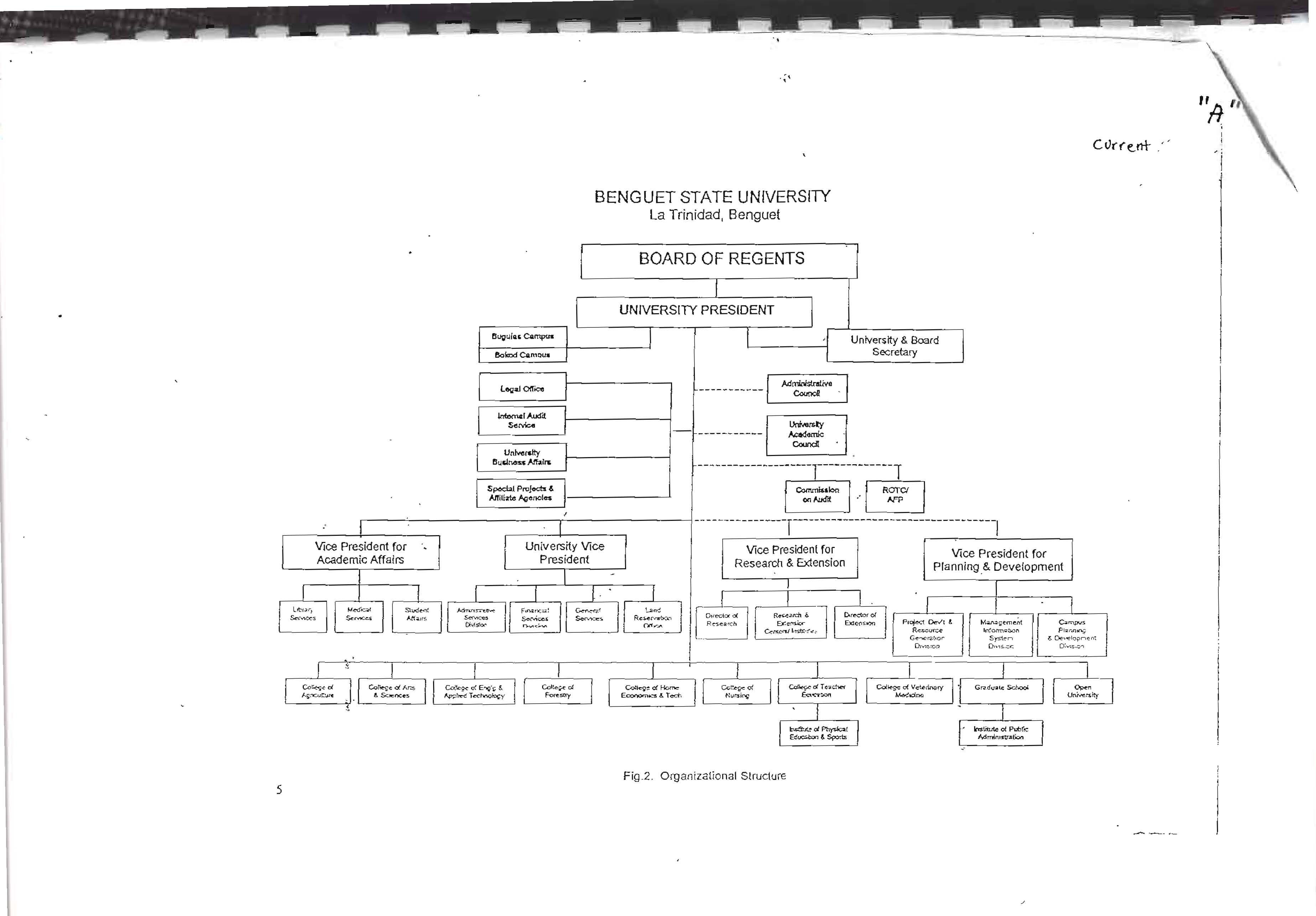
.~\\
CV((e..flt
BENGUET STATE UNIVERSITY
La Trinidad, Benguet
BOARD OF REGENTS
5"Oul.. Campus
University & Board
&icod'CamoU'a
Secretary
[
I
l"llaJ =000
I
-----------1 M~ -
l ~1Au<f~ I
S~Nlc<o
I
-----------[EJ.
I Un........1ty I
5uoln4S0 Mo.",
I
---------------~----
-------------1
I Sp6ClaJ Proloct. lo I
Commlulon
~
MiU>bo Ag.ncl..
O<1N1d"~
. , ~
-----~-----------------------.r,'--------------------~I----------------r-----------------------------------1
' - 1
,
Fig2. Organizational Structure
5
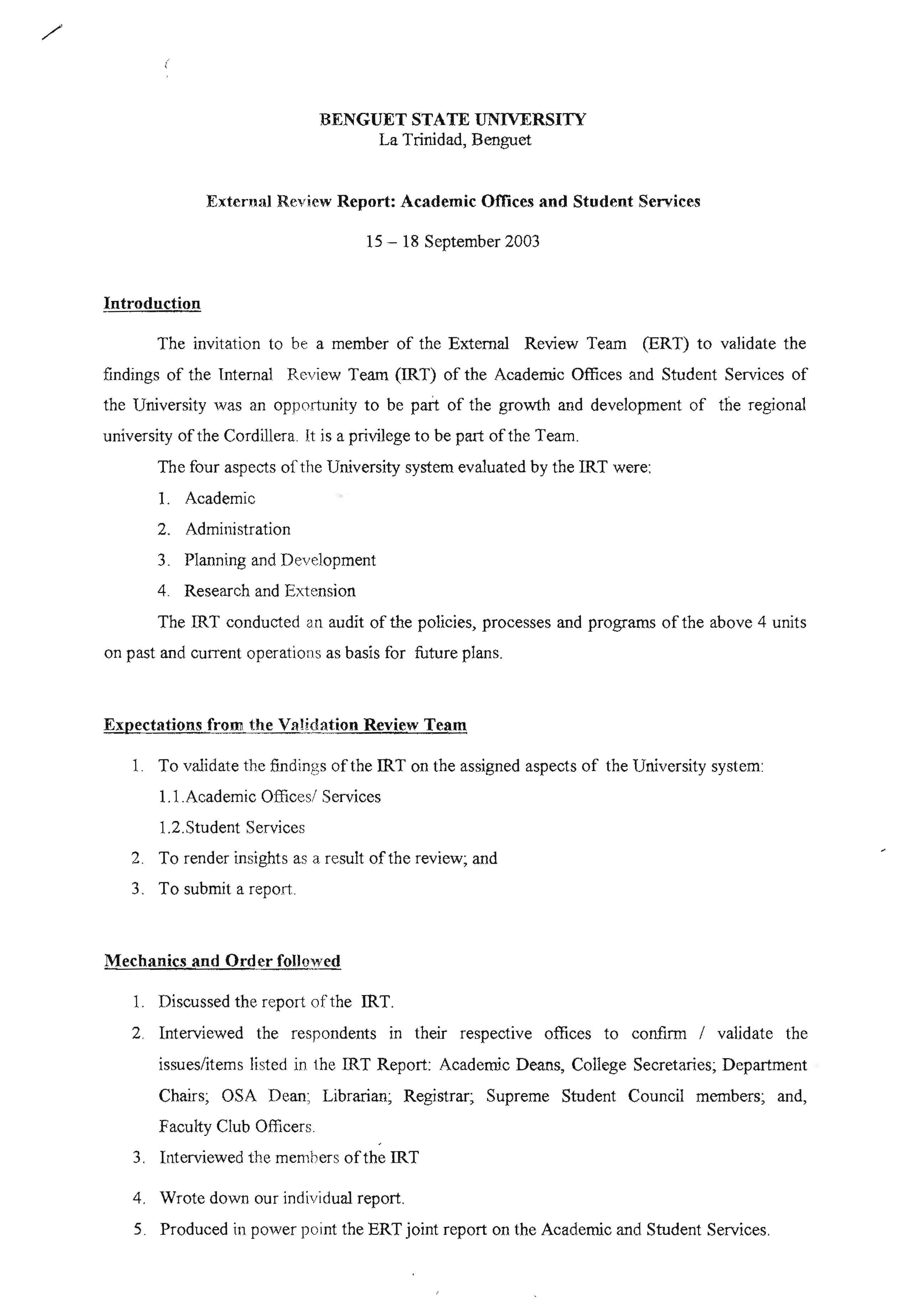
/
BENGUET STATE UNIVERSITY
La Trinidad, Benguet
External Review Report: Academic Offices and Student Services
15 - 18 September 2003
Introduction
The invitation to be a member of the External Review Team (ERT) to validate the
findings of the Internal Review Team (IRT) of the Academic Offices and Student Services of
the University was an opportunity to be part of the growth and development of the regional
university of the Cordillera. It is a privilege to be part of the Team.
The four aspects of the University system evaluated by the IRT were:
1. Academic
2. Administration
3. Planning and Development
4. Research and Extension
The IRT conducted an audit of the policies, processes and programs of the above 4 units
on past and current operations as basis for future plans.
EXQectations from the Validation Review Team
1. To validate the findings of the IRT on the assigned aspects of the University system:
1.I.Academic Offices! Services
1.2.Student Services
2. To render insights as a result of the review~ and
3. To submit a report.
Mechanics and Order folJo.YI'ed
1. Discussed the report of the IRT.
2. Interviewed the respondents in their respective offices to confirm / validate the
issues/items listed in the IRT Report: Academic Deans, College Secretaries; Department
Chairs~ OSA Dean; Librarian; Registrar; Supreme Student Council members; and,
Faculty Club Officers.
3. Interviewed the members of the IRT
4. Wrote down our individual report.
5. Produced in power point the ERT joint report on the Academic and Student Services.
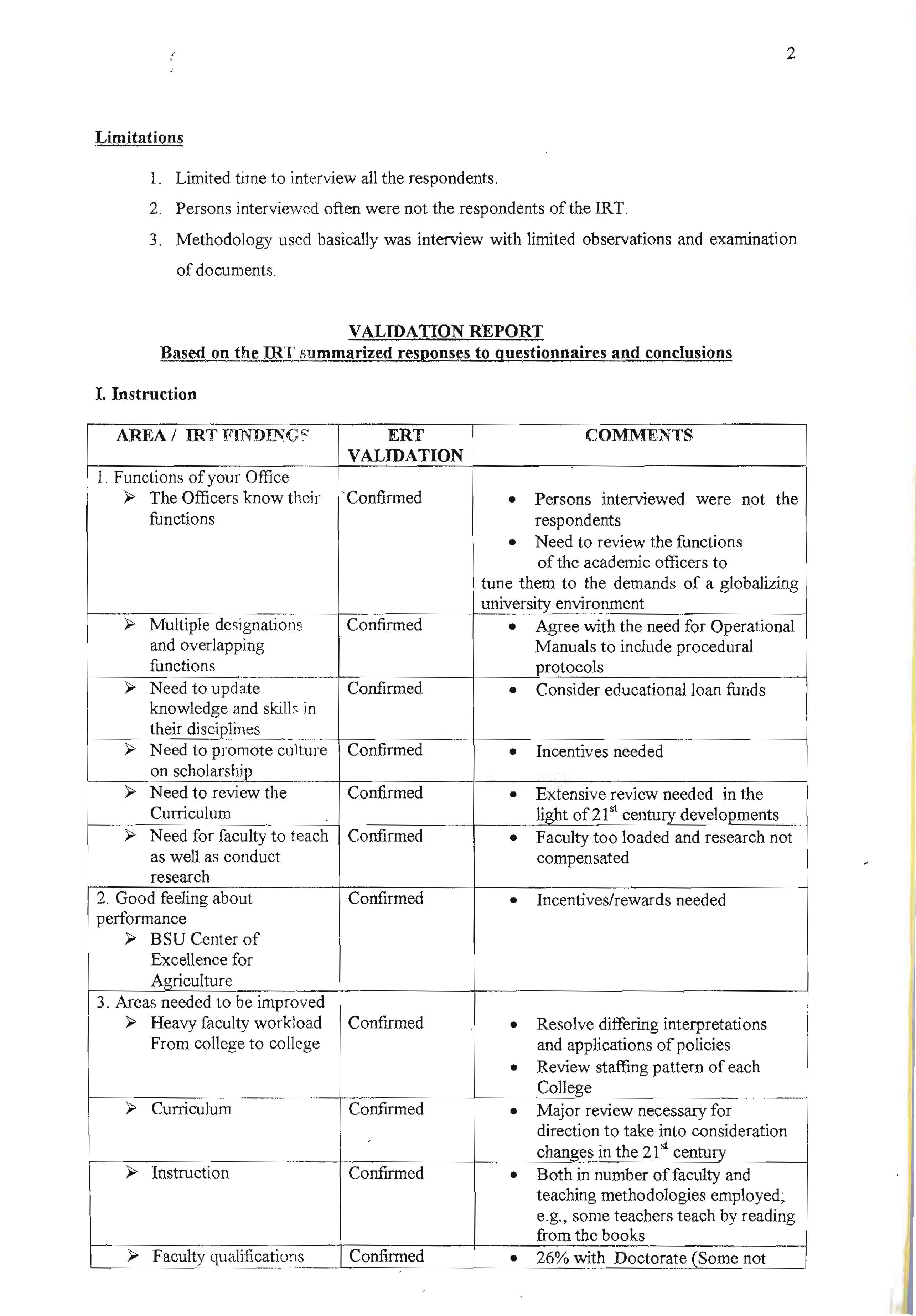
:'
2
Limitations
1. Limited time to interview all the respondents.
2. Persons interviev.;ed often were not the respondents of the IRT.
3. Methodology used basically was interview with limited observations and examination
of documents.
VALIDAnON REPORT
Based on the ffiT summarized responses to questionnaires and conclusions
I. Instruction
AREA / ffiT FINDING~
ERT
COMMENTS
VALIDATION
1. Functions of your Office
» The Officers know their 'Confirmed
• Persons interviewed were not the
functions
respondents
• Need to review the functions
of the academic officers to
tune them to the demands of a globalizing
university environment
~ Multiple designations
Confirmed
• Agree with the need for Operational
and overlapping
Manuals to include procedural
functions
protocols
»
...
Need to update
Confirmed
• Consider educational loan funds
knowledge and skills in
their disciplines
~ Need to promote cu1ture Confirmed
• Incentives needed
on scholarship
» Need to review the
Confirmed
• Extensive review needed in the
Curriculum
light of 21 st century developments
» Need for faculty to teach Confirmed
• Faculty too loaded and research not
as well as conduct
compensated
research
2. Good feeling about
Confirmed
• Incentiveslrewards needed
performance
» BSU Center of
Excellence for
Agriculture
3. Areas needed to be improved
» Heavy faculty workloa.d Confirmed
• Resolve differing interpretations
From college to college
and applications of policies
• Review staffing pattern of each
College
. .
~ Curriculum
Confirmed
• Major review necessary for
direction to take into CQnsideration
changes in the 21 st century
-
» Instruction
Confirmed
• Both in number offaculty and
teaching methodologies employed;
e.g., some teachers teach by reading
from the books
» Faculty qualifications
Confirmed
• 26% with Doctorate (Some not i
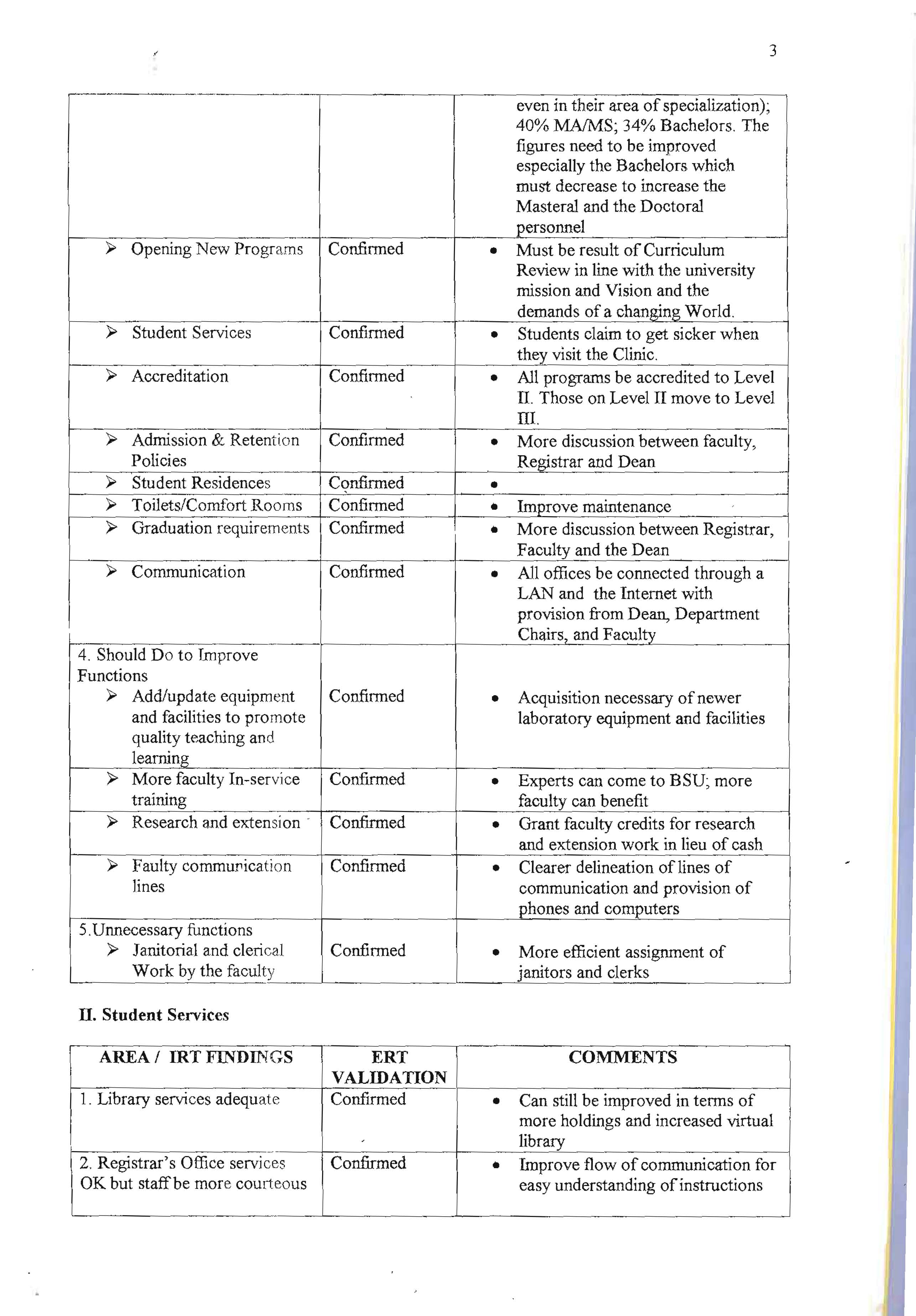
.<
3
~.
even in their area of specialization);
40% MAIMS; 34% Bachelors. The
figures need to be improved
especially the Bachelors which
must decrease to increase the
Masteral and the Doctoral
personnel
);> Opening New Programs
Confirmed
• Must be result of Curriculum
Review in line with the university
mission and Vision and the
demands of a changing World.
-
);> Student Services
Confirmed
• Students claim to get sicker when
they visit the Clinic.
);> Accreditation
Confirmed
• All programs be accredited to Level
n. Those on Level II move to Level
III.
);> Admission & Retention
Confirmed
• More discussion between faculty,
Policies
Registrar and Dean
);>
Student Residences
Confirmed
•
);> Toilets/Comfort Rooms
Confirmed
• Improve maintenance
~ Graduation requirements Confirmed
• More discussion between Registrar,
Faculty and the Dean
);>
Communication
Confirmed
• All offices be connected through a
LAN and the Internet with
provision from Dean, Department
Chairs, and Faculty
4. Should Do to Improve
Functions
);>
Add/update equipment
Confirmed
• Acquisition necessary ofnewer
and facilities to promote
laboratory equipment and facilities
quality teaching and
learning
~ More faculty In-service
Confirmed
• Experts can come to BSU; more
training
faculty can benefit
~ Research and extensi on
Confirmed
• Grant faculty credits for research
and extension work in lieu of cash
);> Faulty commuf1ication
Confirmed
• Clearer delineation of lines of
lines
communication and provision of
phones and computers
5.Unnecessary functions
~ Janitorial and clerical
Confirmed
• More efficient assignment of
Work by the faculty
janitors and clerks
U. Student Services
AREA I IRT FINDINGS
ERT
COMMENTS
VALIDATION
1. Library services adequate
Confirmed
• Can still be improved in terms of
more holdings and increased virtual
,
library
2. Registrar's Office services
Confirmed
• Improve flow ofcommunication for
OK but staffbe more COUlieous
easy understanding of instructions
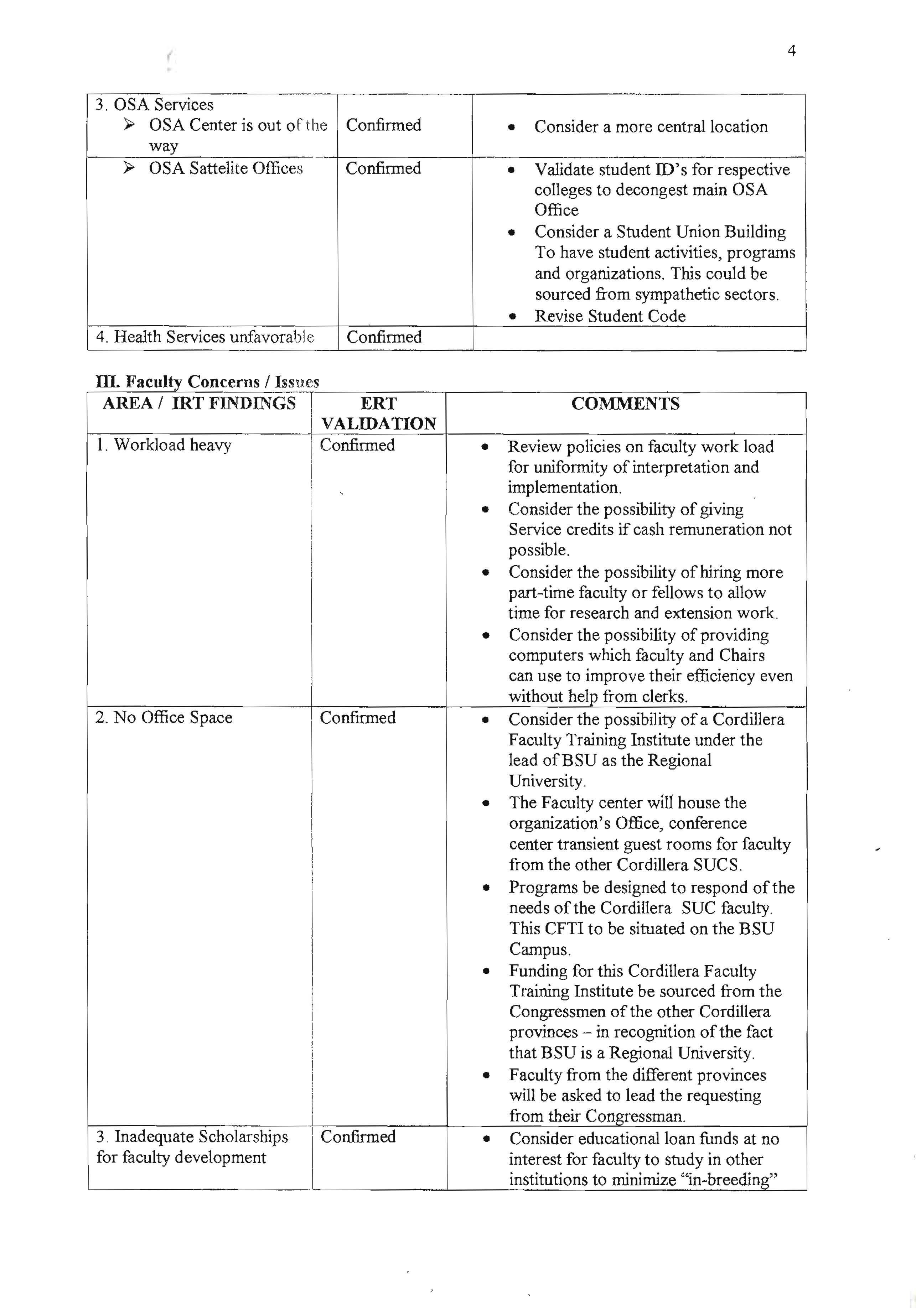
4
3, OSA Services
~ OSA Center is out of the Confirmed
• Consider a more central location
way
- -
» OSA Sattelite Offices
Confirmed
• Validate student ill's for respective
colleges to decongest main OSA
Office
• Consider a Student Union Building
To have student activities, programs
and organizations. This could be
sourced from sympathetic sectors.
• Revise Student Code
4. Health Services unfavorable
Confinned
Ill. Faculty Concerns I Issues
AREA I IRT FINDINGS "1
ERT
COMMENTS
VALIDATION
1. Workload heavy
Confirmed
• Review policies on faculty work load
for uniformity of interpretation and
'.
implementation.
• Consider the possibility of giving
Service credits if cash remuneration not
possible.
• Consider the possibility of hiring more
part-time faculty or fellows to allow
time for research and extension work.
• Consider the possibility of providing
computers which faculty and Chairs
can use to improve their efficiency even
without help from clerks.
2. No Office Space
Confinned
• Consider the possibility ofa Cordillera
Faculty Training Institute under the
lead ofBSU as the Regional
University.
• The Faculty center wiI1 house the
organization's Office, conference
center transient guest rooms for faculty
from the other Cordillera SUCS.
• Programs be designed to respond ofthe
needs of the Cordillera SUC faculty.
This CFTI to be situated on the BSU
Campus.
• Funding for this Cordillera Faculty
Training Institute be sourced from the
Congressmen of the other Cordillera
provinces - in recognition of the fact
that BSU is a Regional University.
• FacuIty from the different provinces
will be asked to lead the requesting
from their Congressman.
3. Inadequate Scholarships
I Confirmed
• Consider educational loan funds at no
for faculty development
interest for faculty to study in other
institutions to minimize "in-breeding"
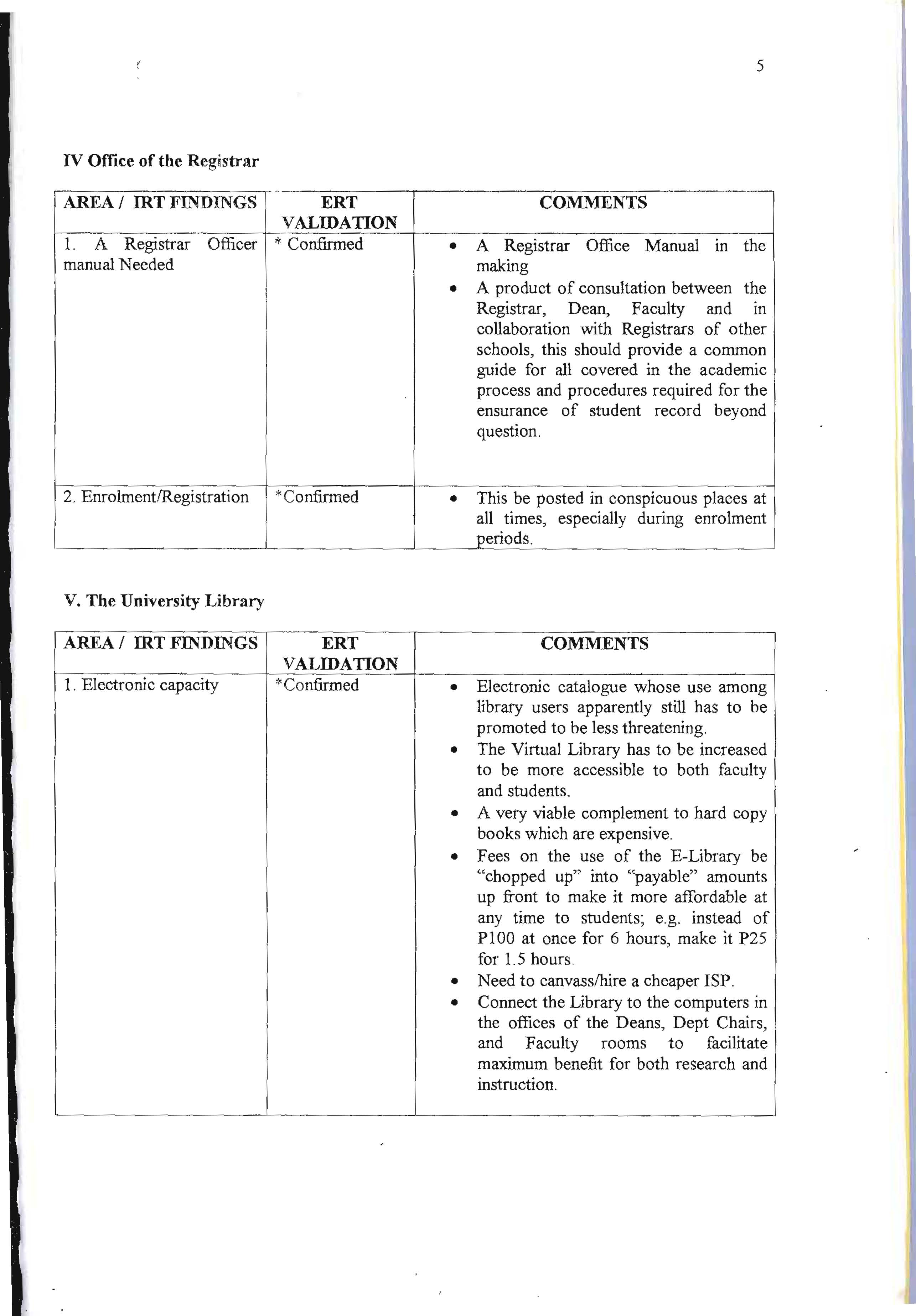
5
IV Office of the Registrar
r - - - - - - - - - - - - - , - - ---.---~---__r_----.-~---~.---------------
AREA I IRT FINDINGS
ERT
COMMENTS
VALIDATION
f - - - - - - - - - - - - - i - -
1.
A Registrar Officer * Confinned
•
A Registrar Office Manual in the
manual Needed
making
•
A product of consultation between the
Registrar,
Dean,
Faculty
and
In
collaboration with Registrars of other
schools, this should provide a common
guide for all covered in the academic
process and procedures required for the
ensurance of student record beyond
question.
2. EnrolmentlRegistration
*Confinned
•
This be posted in conspicuous places at
all times, especially during enrolment
periods.
V. The University Library
AREA I IRT FINDINGS
ERT
COMMENTS
VALIDATION
1. Electronic capacity
;I< Confirmed
• Electronic catalogue whose use among
library users apparently still has to be
promoted to be less threatening.
•
The Virtual Library has to be increased
to be more accessible to both faculty
and students.
•
A very viable complement to hard copy
books which are expensive.
• Fees on the use of the E-Library be
"chopped up" into «payable" amounts
up front to make it more affordable at
any time to students; e.g. instead of
PI00 at once for 6 hours, make it P25
for 1.5 hours.
•
Need to canvasslhire a cheaper ISP.
•
Connect the Library to the computers in
the offices of the Deans, Dept Chairs,
and
Faculty
rooms
to
facilitate
maximum benefit for both research and
instruction.
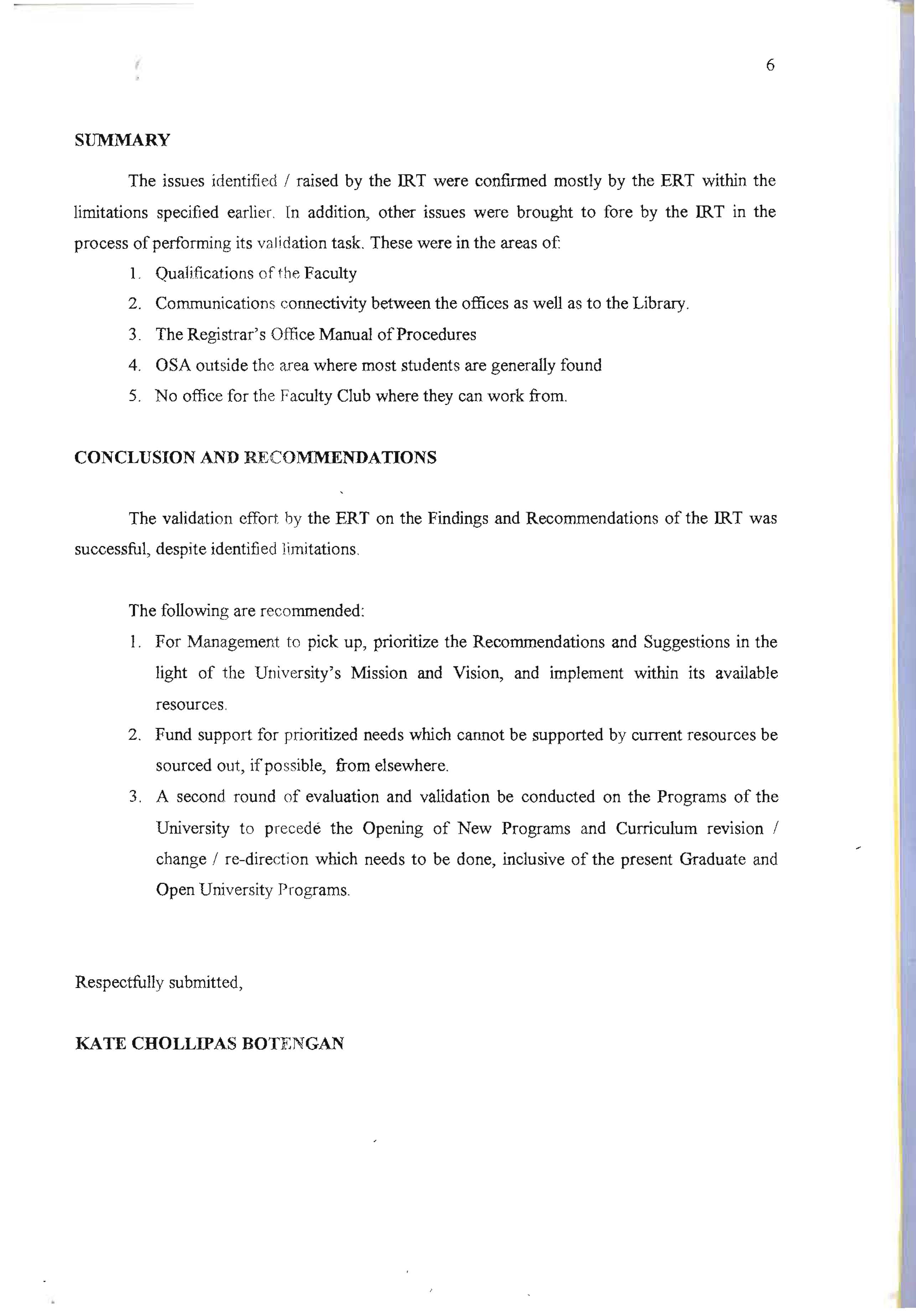
(
6
SUMMARY
The issues identified I raised by the lRT were confirmed mostly by the ERT within the
limitations specified earlier. In addition, other issues were brought to fore by the lRT in the
process of performing its va Ii dation task. These were in the areas of
1. Qualifications of the Faculty
2. Communications connectivity between the offices as well as to the Library.
3. The Registrar's Office Manual of Procedures
4. GSA outside the area where most students are generally found
5. No office for the Faculty Club where they can work from.
CONCLUSION AND RECOMMENDATIONS
The validation effort by the ERT on the Findings and Recommendations of the lRTwas
successful, despite identified limitations.
The following are recommended:
1. For Management to pick up, prioritize the Recommendations and Suggestions in the
light of the University's Mission and Vision, and implement within its available
resources.
2. Fund support for prioritized needs which cannot be supported by current resources be
sourced out, ifpossible, from elsewhere.
3. A second round of evaluation and validation be conducted on the Programs of the
University to precede the Opening of New Programs and Curriculum revision I
change I re-direction which needs to be done, inclusive of the present Graduate and
Open University Programs.
Respectfully submitted,
KATE CHOLLJPAS BOTENGAN
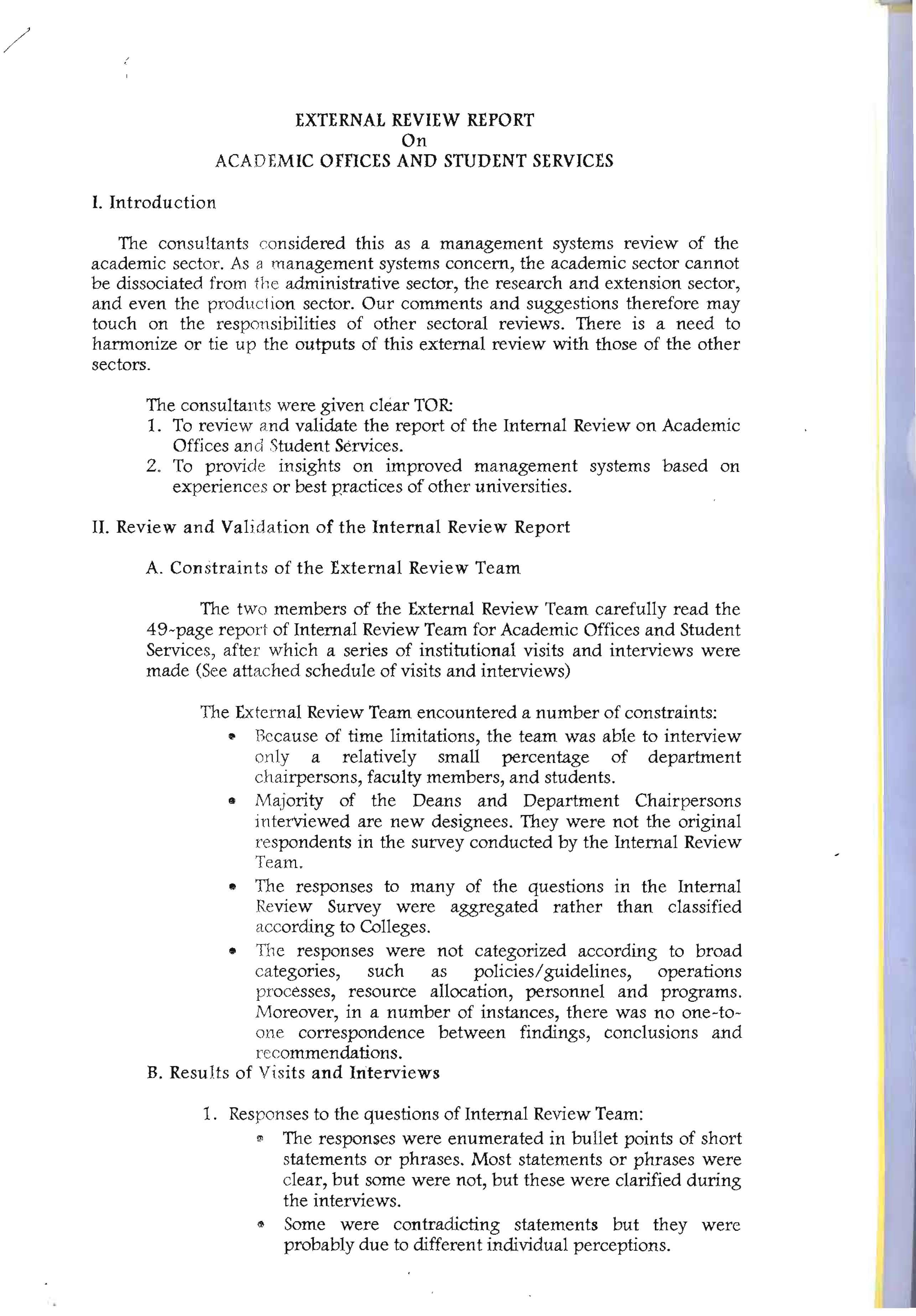
/
EXTERNAL REVIEW REPORT
On
ACADEMIC OFFICES AND STUDENT SERVICES
1. Introduction
The consultants considered this as a management systems review of the
academic sector. As a management systems concern, the academic sector cannot
be dissociated from t}le administrative sector, the research and extension sector,
and even the produc1 ion sector. Our comments and suggestions therefore may
touch on the responsibilities of other sectoral reviews. There is a need to
harmonize or tie up the outputs of this external review with those of the other
sectors.
The consultants were given clear TOR:
1. To review and validate the report of the Internal Review on Academic
Offices and Student Services.
2. To provide insights on improved management systems based on
experiences or best practices of other universities.
II. Review and Validation of the Internal Review Report
A. Constraints of the External Review Team
The two members of the External Review Team carefully read the
49-page report of Internal Review Team for Academic Offices and Student
Services, after which a series of institutional visits and interviews were
made (See attached schedule of visits and interviews)
The External Review Team encountered a number of constraints:
'"
Because of time limitations, the team was able to interview
only
a
relatively small
percentage of department
chairpersons, faculty members, and students.
• Majority of the Deans and Department Chairpersons
interViewed are new designees. They were not the original
respondents in the survey conducted by the Internal Review
Team.
• The responses to many of the questions in the Internal
Review Survey were aggregated rather than classified
according to Colleges.
• TIle responses were not categorized according to broad
categories,
such
as
policies/guidelines,
operations
pmcesses, resource allocation, personnel and programs.
Moreover, in a number of instances, there was no one-to
one correspondence between findings, conclusions and
recommendations.
B. Results of Visits and Interviews
1. Responses to the questions of Internal Review Team:
1l'
The responses were enumerated in bullet points of short
statements or phrases. Most statements or phrases were
clear, but some were not, but these were clarified during
the interviews.
~ Some were contradicting statements but they were
probably due to different individual perceptions.
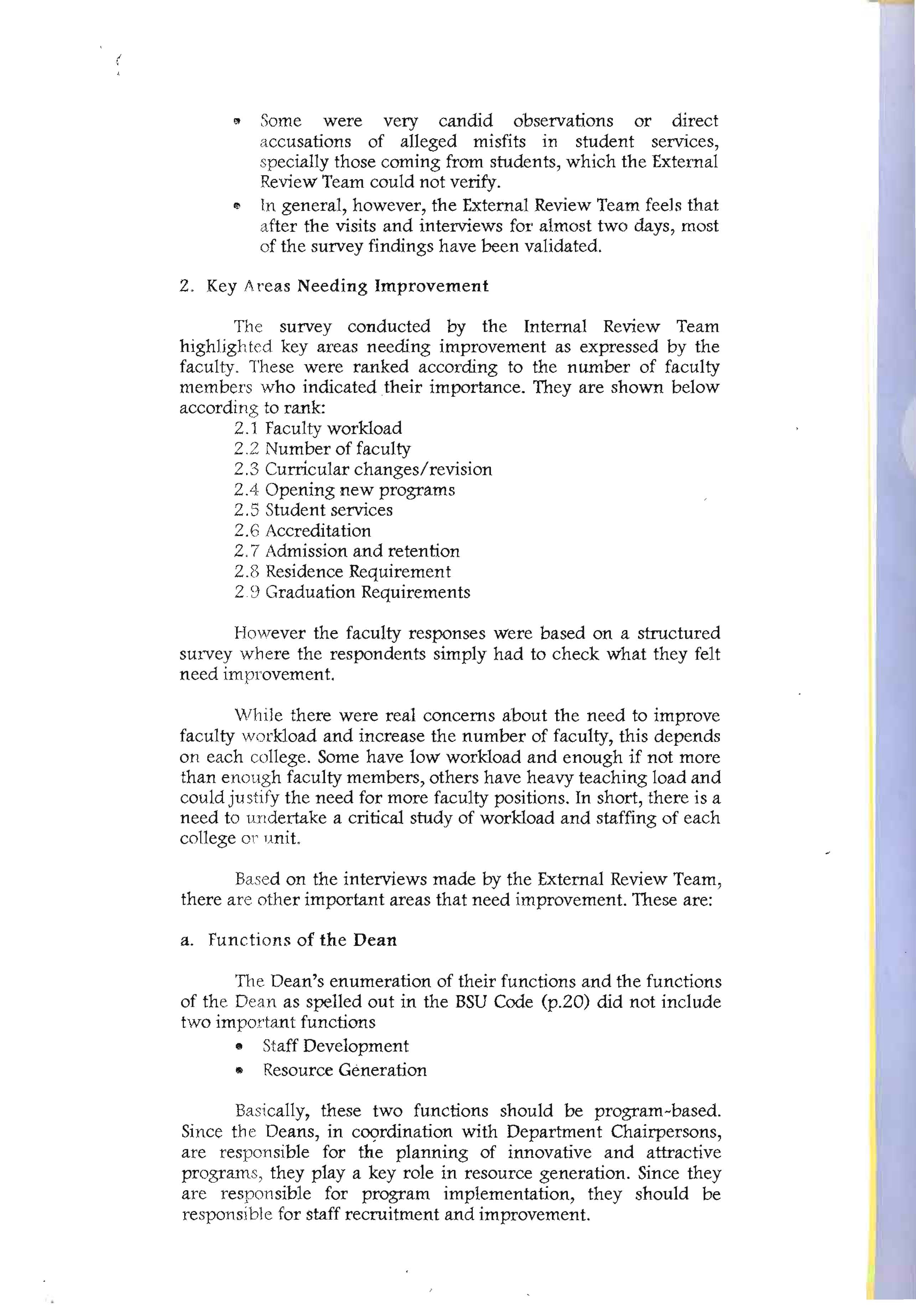
.(
!lI
Some
were very candid observations or direct
accusations of alleged misfits in student services,
specw.lly those coming from students, which the External
Review Team could not verify.
o
In general, however, the External Review Team feels that
after the visits and interviews fol' almost two days, most
of the survey findings have been validated.
2. Key Areas Needing Improvement
The survey conducted by the Internal Review Team
highligh ted key areas needing improvement as expressed by the
faculty. These were ranked according to the number of faculty
members who indicated their importance. They are shown below
according to rank:
2.1 Faculty workload
2.2 Number of faculty
2.3 Curricular changes/revision
2.4 Opening new programs
2.5 Student services
2.6 Accreditation
2.7 Admission and retention
2.8 Residence Requirement
2.9 Graduation Requirements
However the faculty responses were based on a structured
survey where the respondents simply had to check What they felt
need improvement.
VI/hile there were real concerns about the need to improve
faculty workload and increase the number of faculty, this depends
on each college. Some have low workload and enough if not more
than enough faculty members, others have heavy teaching load and
could ju stify the need for more faculty positions. In short, there is a
need to undertake a critical study of workload and staffing of each
college or unit.
Based on the interviews made by the External Review Team,
there are other important areas that need improvement. These are:
a. Functions of the Dean
'TIle Dean's enumeration of their functions and the functions
of the Dean as spelled out in the BSU Code (p.20) did not include
two important functions
• Staff Development
• Resource Generation
Basically, these two functions should be program-based.
Since the Deans, in cO<?rdination with Department Chairpersons,
are responsible for the planning of innovative and attractive
programs, they playa key role in resource generation. Since they
are responsible for program implementation, they should be
responsible for staff recruitment and improvement.
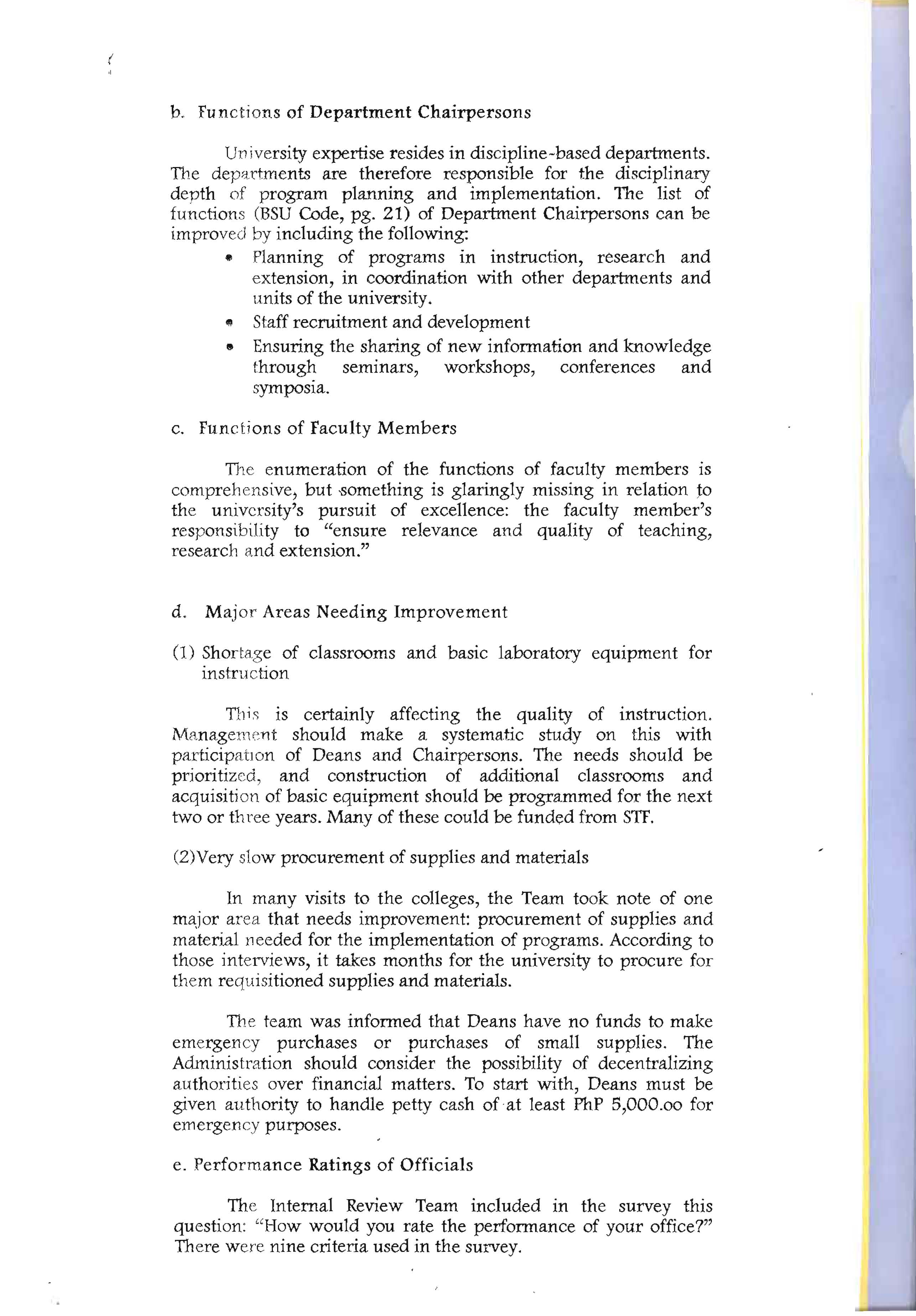
,I
b. Functions of Department Chairpersons
Ul1 iversity expertise resides in discipline-based departments.
The dep~xtments are therefore responsible for the disciplinary
depth of program planning and implementation. The list of
functions (BSU Code, pg. 21) of Department Chairpersons can be
improved by including the following:
411
Planning of programs in instruction, research and
extension, in coordination with other departments and
units of the university.
'" Staff recruitment and development
8
Ensuring the sharing of new infonnation and knowledge
through
seminars,
workshops,
conferences
and
sympoSia.
c. Functions of Faculty Members
The enumeration of the functions of faculty members is
comprehensive, but -something is glaringly missing in relation to
the university's pursuit of excellence: the faculty member's
responsibility to "ensure relevance and quality of teaching,
research and extension."
d. Major Areas Needing Improvement
(1) Shortage of classrooms and basic laboratory equipment for
instru chon
TIl;,<; is certainly affecting the quality of instruction.
Management should make a systematic study on this with
participatIon of Deans and Chairpersons. The needs should be
prioritized, and construction of additional classrooms and
acquisition of basic equipment should be progra.mmed for the next
two or three years. Many of these could be funded from STF.
(Z)Very slow procurement of supplies and materials
In many visits to the colleges, the Team took note of one
major area that needs improvement: procurement of supplies and
material lleeded for the implementation of programs. According to
those interviews, it takes months for the university to procure for
them requisitioned supplies and materials.
The team was infonned that Deans have no funds to make
emergency purchases or purchases of small supplies. The
Administration should consider the possibility of decentralizing
authorities over financial matters. To start with, Deans must be
given authority to handle petty cash of at least Phr 5,000.00 for
emergency purposes.
e. Performance Ratings of Officials
The Internal Review Team included in the survey this
question: "How would you rate the perfonnance of your office?"
There were nine criteria used in the survey.
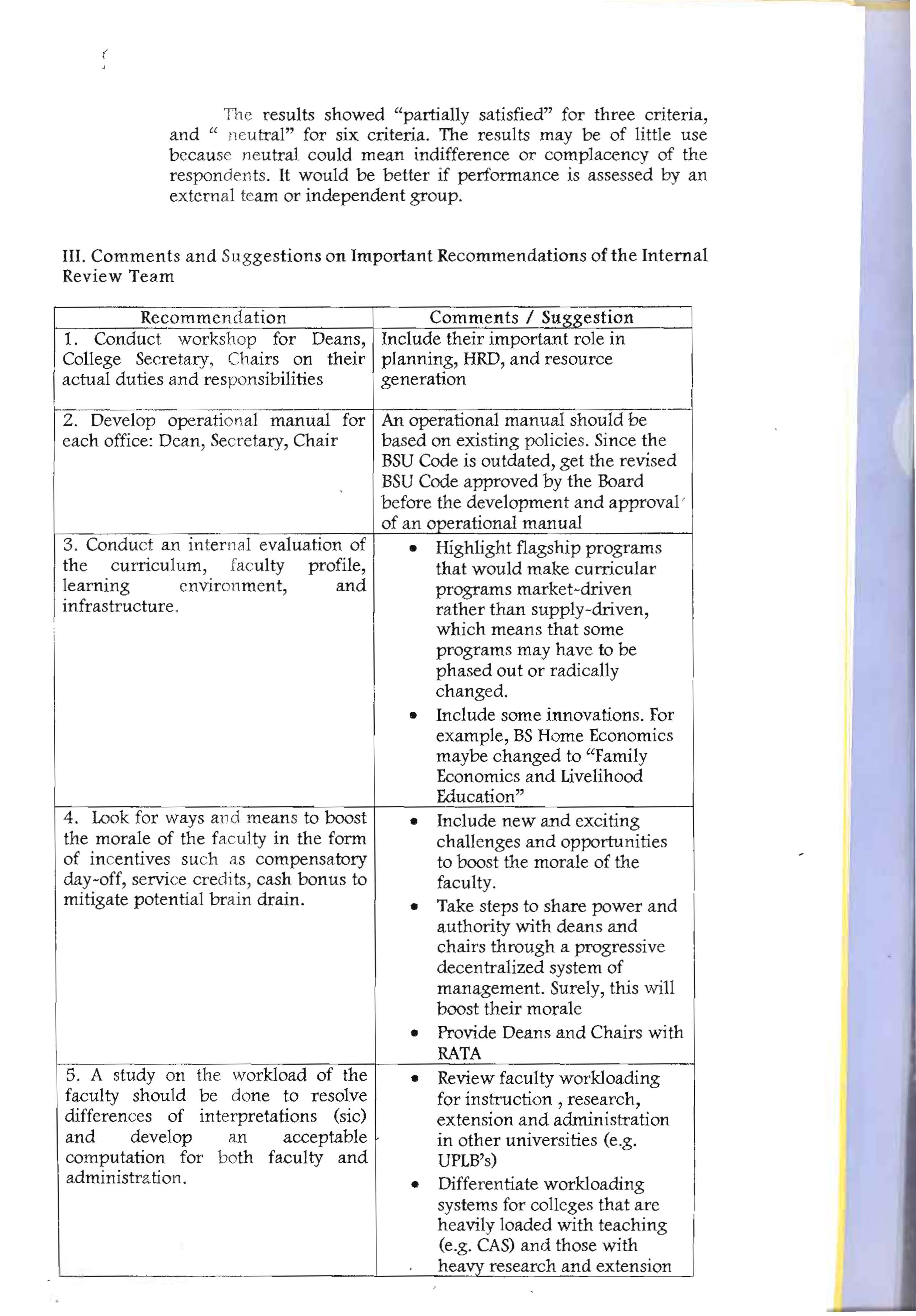
(
The results showed upartially satisfied" for three criteria,
and a neutral" for six criteria. The results may be of little use
because neutral could mean indifference or complacency of the
respondents. It would be better if performance is assessed by an
external team or independent group.
III. Comments and Suggestions on Important Recommendations ofthe Internal
Review Team
Recommendation
Comments / Suggestion
1. Conduct workshop for Deans, Include their important role in
College Secretary, Chairs on t.heir planning, HRD, and resource
actual duties and responsibilities
generation
2. Developoperatlon-alc-m-a-n-u-al---:---:Ofo-r--+----.,.-An-o-pe-r-ah--:-·o-n-a--::;l-m-an-u-a-:l~s--::;-h-o-u--;-ld~b-e--'-
each office: Dean, Secretary, Chair
based on existing policies. Since the
BSU Code is outdated, get the revised
BSU Code approved by the Board
before the development and approval'
of an operational manual
3. Conduct an internal evaluation of
• Highlight flagship programs
the
curriculum,
faculty
profile,
that would make curricular
learning
environment,
and
programs market-driven
infrastructure.
rather than supply-driven,
which means that some
programs may have to be
phased out or radically
changed.
• Include some innovations. For
example, BS Home Economics
maybe changed to "Family
Economics and Livelihood
Education"
4. Look for ways and means to boost
• Include new and exciting
the morale of the faculty in the fonn
challenges and opportunities
of incentives such as compensatory
to boost the morale of the
day-off, service credits, cash bonus to
faculty.
mitigate potential brain drain.
• Take steps to share power and
authority with deans and
chairs through a progressive
decentralized system of
management. Surely, this will
boost their morale
• Provide Deans and Chairs with
RATA
5. A study on the workload of the
• Review faculty workloading
faculty should be done to resolve
for instruction, research,
differences of interpretations (sic)
extension and administration
and
develop
an
acceptable
in other universities (e.g.
computation for both faculty and
UPLB's)
administration.
• Differentiate workloading
systems for colleges that are
heavily loaded with teaching
(e.g. CAS) and those with
heavy research and extension
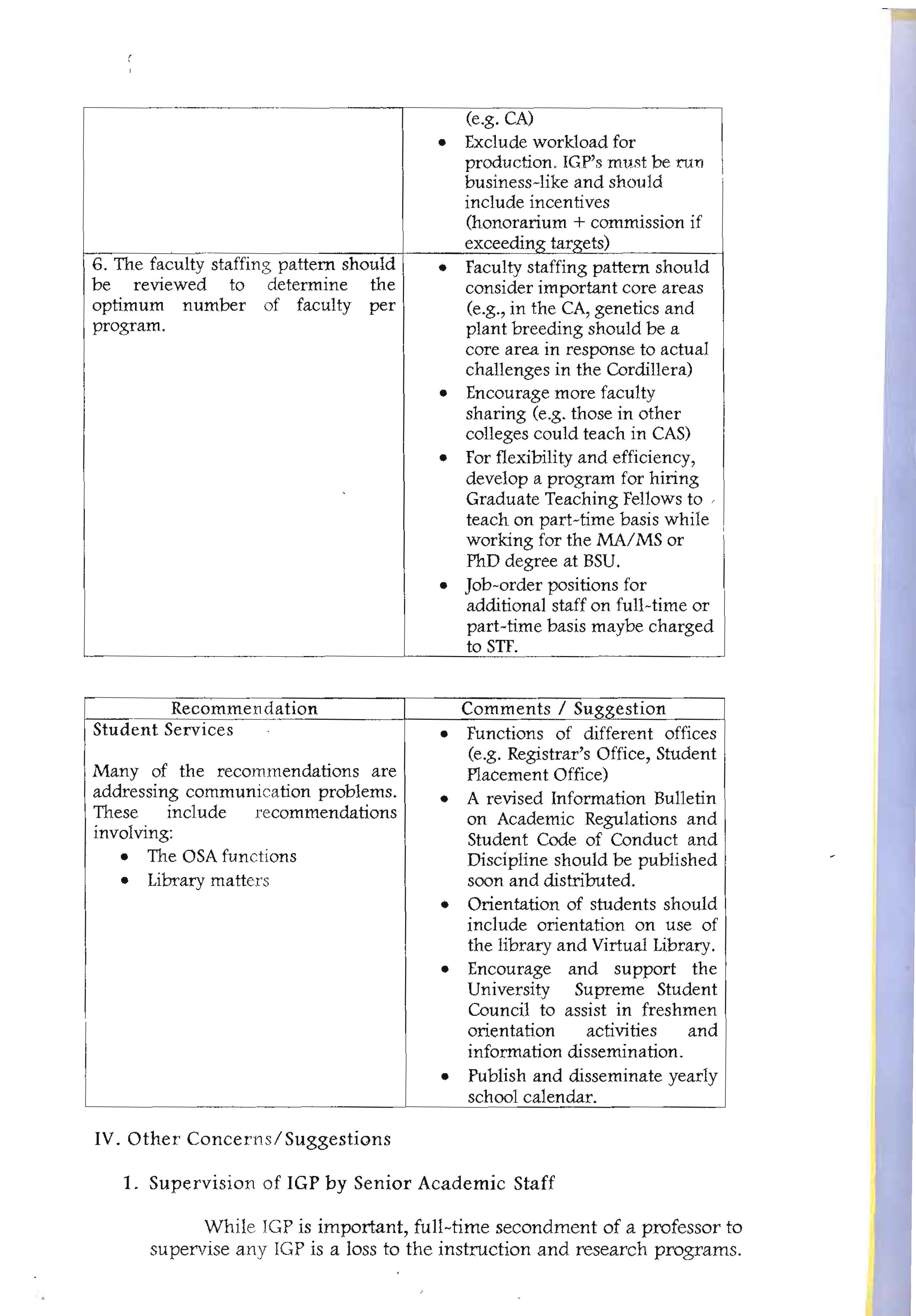
(e.g. CA)
• Exclude workload for
production. IGP's must be nt-rt
business-like and should
include incentives
(honorarium + commission if
exceedin~ tar~ets)
6. The faculty staffing pattern should
• Faculty staffing pattern should
be
reviewed
to
determine
the
consider important core areas
optimum number of faculty per
(e.g., in the CA, genetics and
program.
plant breeding should be a
core area in response to actual
challenges in the Cordillera)
• Encourage more faculty
sharing (e.g. those in other
colleges could teach in CAS)
• For flexibility and efficiency,
develop a program for hiring
Graduate Teaching Fellows to '
teach on part-time basis while I
working for the MAIMS or
PhD degree at BSU.
• Job-order positions for
additional staff on full-time or
part-time basis maybe charged
to SIT.
Recommen d:::a~t::..:io:::..:n:..:...-_ _~-+
C=-o=-m=m=-=-en~ts~/---=S---=u.:sL9,:li.:9,:L,e:-..::s_h_·
o...;,.n_ _----J
Student Services
• Functions of different offices
(e.g. Registrar's Office, Student
Many of the recommendations are
Placement Office)
addressing communication problems.
• A revised Information Bulletin
These
include
recommendations
on Academic Regulations and
involving:
Student Code of Conduct and
• The OSA functions
Discipline should be published
• Library matters
soon and distributed.
• Orientation of students should
include orientation on use of
the library and Virtual Library.
• Encourage and support the
University
Supreme Student
Council to assist in freshmen
orientation
activities
and
information dissemination.
• Publish and disseminate yearly
school calendar.
IV. Other Concernsl Suggestions
1. Supervision of IGP by Senior Academic Staff
While IGP is important, full-time secondment of a professor to
supervise any IGP is a loss to the instruction and research programs.
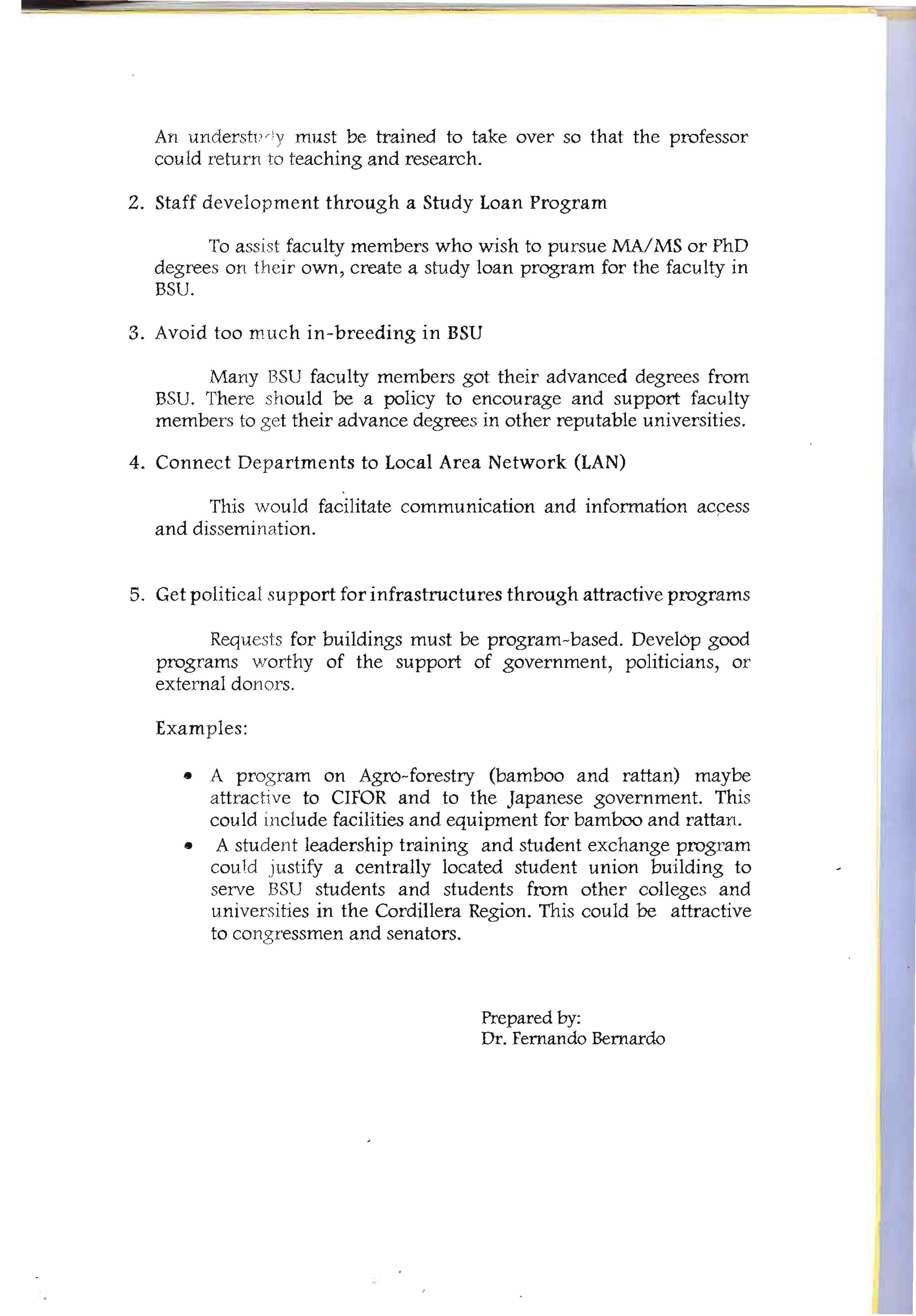
Art understv,iy must be trained to take over so that the professor
could return to teaching and research.
Z. Staff development through a Study Loan Program
To assist faculty members who wish to pursue MAIMS or PhD
degrees on their own, create a study loan program for the faculty in
BSU.
3. Avoid too much in-breeding in BSU
.Many BSU faculty members got their advanced degrees from
BSU. There should be a policy to encourage and support faculty
members to get their advance degrees in other reputable universities.
4. Connect Departments to Local Area Network (LAN)
This would facilitate communication and infonnation ac~ess
and dissemination.
5. Get political support for infrastructures through attractive programs
Requests for buildings must be program-based. Develop good
programs worthy of the support of government, politicians, or
external donors.
Examples:
• A program on Agro-forestry (bamboo and rattan) maybe
attractive to crFOR and to the Japanese government. This
could include facilities and equipment for bamboo and rattan.
• A student leadership training and student exchange program
could justify a centrally located student union building to
serve BSU students and students from other colleges and
universities in the Cordillera Region. This could be attractive
to congressmen and senators.
Prepared by:
Dr. Fernando Bernardo
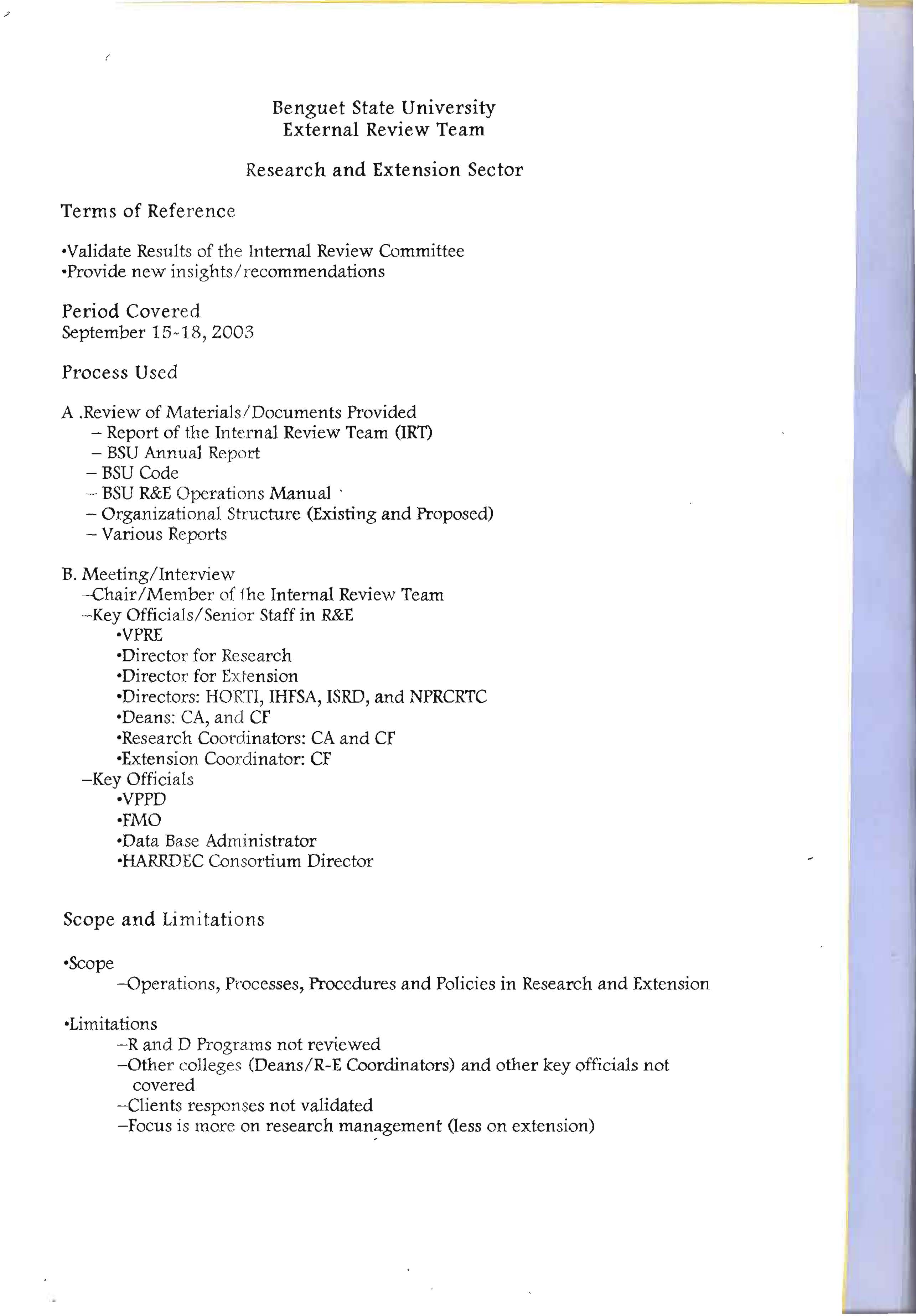
{
Benzuet State University
External Review Team
Research and Extension Sector
Terms of Reference
-Validate Results of the Intern.al Review Committee
wprovide new insights/recommendations
Period Covered
September 15-18,2003
Process Used
A .Review of Materials/Documents Provided
- Report of the Internal Review Team (IRT)
- BSU Annual Report
- BSU Code
- BSU R&E Operations Manual .
- Organizational Structure (Existing and Proposed)
- Various Reports
B. Meeting/Interview
-Chair/Member of 1he Internal Review Team
-Key Officials/Senior Staff in R&E
-VPRE
-Director for Research
-Director for Extension
-Directors: HaRTl, IHFSA, ISRD, and NPRCRTC
-Deans: CA, and CF
-Research Coordinators: CA and CF
-Extension Coordinator: CF
-Key Officials
·VPPD
-FMO
-Data Base Administrator
-HARRDEC Consortium Director
Scope and Limitations
-Scope
-Operations, Processes, Procedures and Policies in Research and Extension
-Limitations
-R and D Programs not reviewed
-Other colleges (Deans/R-E Coordinators) and other key officials not
covered
~Clients responses not validated
-Focus is more on research management (less on extension)
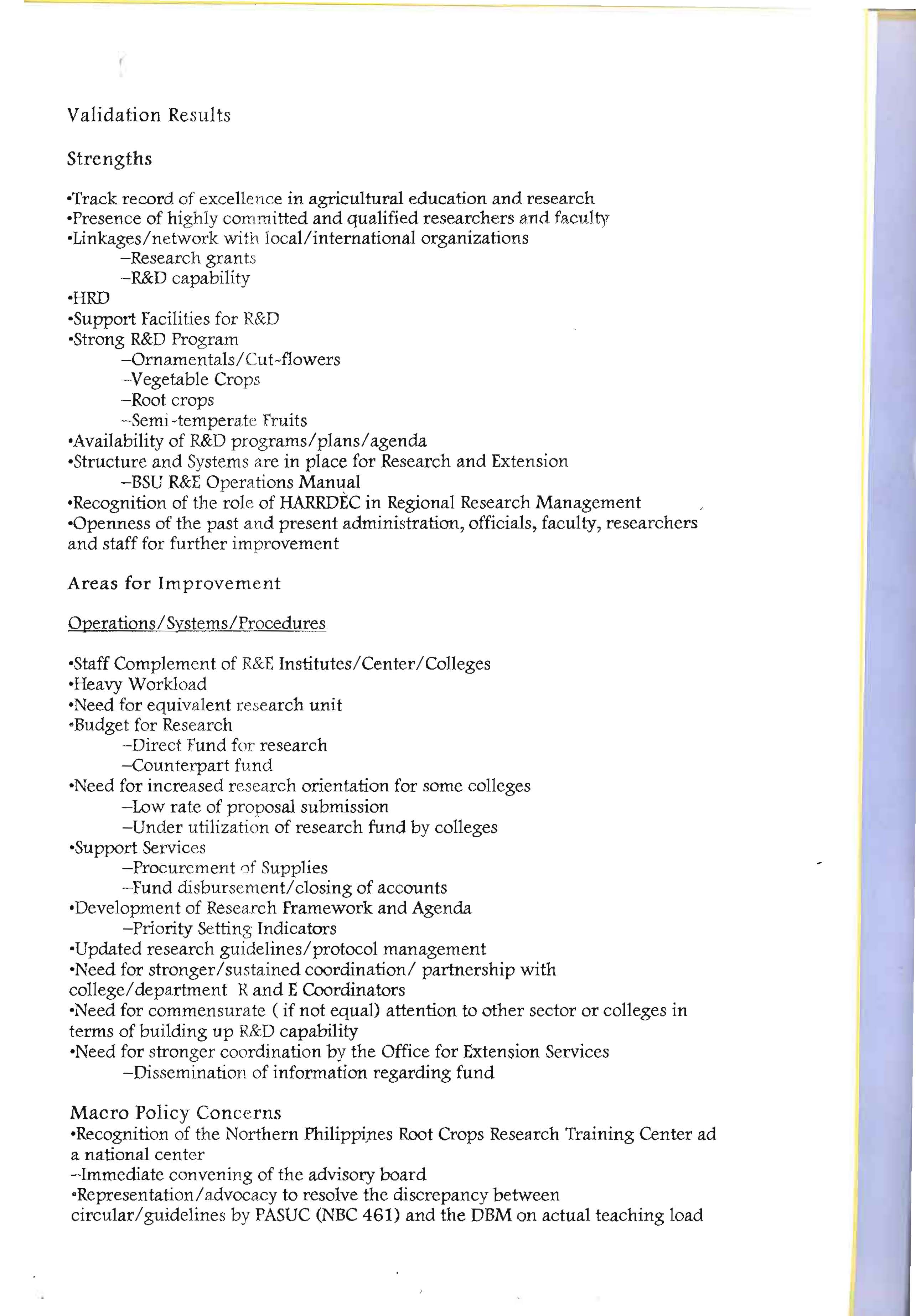
Validation Results
Strengths
-Track record of excellence in agricultural education and research
-Presence of highly committed and qualified researchers and faculty
-Linkages/network with local/international organizations
-Research grants
-R&D capability
-HRD
-Support Facilities for R&D
-Strong R&D Program
-Ornamentals/Cut-flowers
-Vegetable Crops
-Root crops
-Semi -temperate fruits
·Availability of R&D programs/plans/agenda
-Structure and Systems are in place for Research and Extension
-BSU R&E Operations Manual
-Recognition of the role of HARRDEC in Regional Research Management
-Openness of the past and present administration, officials, faculty, researchers
and staff for further improvement
Areas for Improvement
Operations/Systems/Procedures
-Staff Complement of R&E Institutes/Center/Colleges
-Heavy Workload
-Need for equivalent research unit
@Budget for Research
-Direct Fund for research
-Counterpart fund
-Need for increased research orientation for some colleges
-Low rate of proposal submission
-Under utilization of research fund by colleges
-Support Services
-Procurement of Supplies
-Fund disbursement/closing of accounts
-Development of Resea-rch Framework and Agenda
-Priority Setting Indicators
-Updated research guidelines/ protocol management
-Need for stronger/sustained coordination/ partnership with
college/department Rand E Coordinators
-Need for commensurate ( if not equal) attention to other sector or colleges in
terms of building up R&D capability
-Need for stronger coordination by the Office for Extension Services
-Dissemination of information regarding fund
Macro Policy Concerns
-Recognition of the Northern Philippipes Root Crops Research Training Center ad
a national center
-Immediate convening of the advisory board
-Representation/advocacy to resolve the discrepancy between
cirCUlar/guidelines by PASUC (NBC 461) and the DBM on actual teaching load
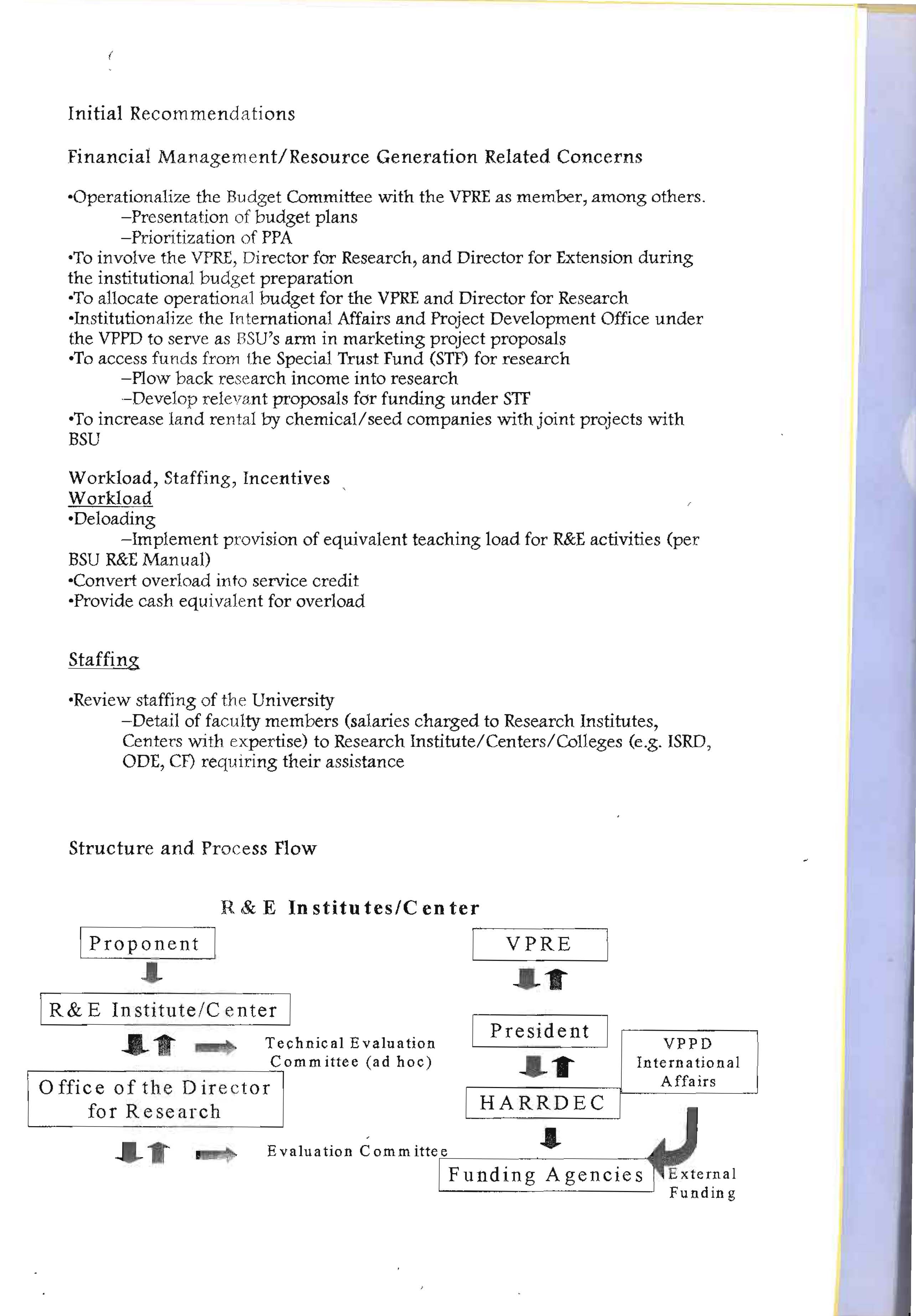
{
Initial Recommendations
Financial Management/Resource Generation Related Concerns
-Operationalize the Budget Committee with the VPRE as member, among others.
-Presentation of budget plans
-Prioritization of PPA
oTo involve the VPRE, Director for Research, and Director for Extension during
the institutional budget preparation
-To allocate operational budget for the VPRE and Director for Research
-Institutionalize the International Affairs and Project Development Office under
the VPPD to serve as BSU~s ann in marketing project proposals
-To access funds from the Special Trust Fund (STF) for research
-Plow back research income into research
--Develop relevant proposals for funding under SIT
-To increase land rental by chemical/seed companies with joint projects with
BSU
Workload~ Staffing, Incentives
Workload
'
-Deloading
-Implement provision of equivalent teaching load for R&E activities (per
BSU R&E Man ual)
-Convert overload into service credit
-Provide cash equivalent for overload
Staffing
oReview staffing of the University
-Detail of faculty members (salaries charged to Research Institutes,
Centers with expertise) to Research Institute/Centers/Colleges (e.g. ISRD,
ODE, CD requ iring their assistance
Structure and Process Flow
R & E In stitu tes/C en ter
I
•
Proponent
VPRE
jR&E Institute/Center
••
President
•
Technical Evaluation
•
VPPD
r -
~
C-,ommittee (ad hoc)
International
Affairs
Office of the Director
for Research
•
Evaluation C omm itte e
•
r " - - - - - - - - - - -
_
Funding Agencies
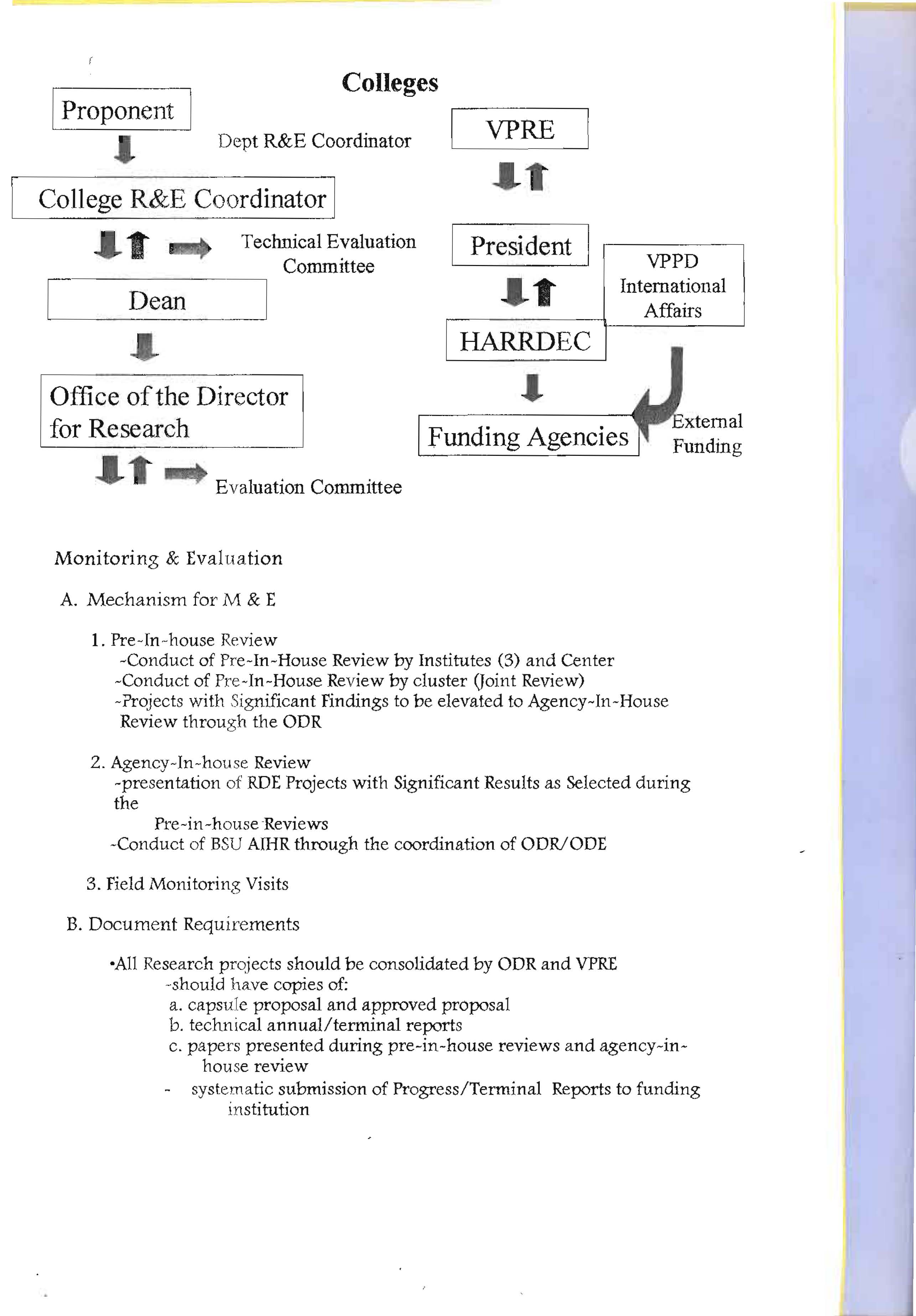
Colleges
I Proponent
VPRE
Dept R&E Coordinator
College R&E Coordinator I
Technical Evaluation
President
Committee
VPPD
International
[ _ _
D_ea_n_~
Affairs
I HARRDEC
Office of the Director
I.
xtemal
for Research
Funding Agencies
Funding
Evaluation Committee
•
Monitoring & Evaluation
A. Mechanism for M & E
1. Pre-In-house Review
-Conduct of Pre-In-House Review by Institutes (3) and Center
-Conduct of Pre-In-House Review by cluster (Joint Review)
-Projects with Significant Findings to be elevated to Agency-In-House
Review through the ODR
z. Agency-In-house Review
-presentation of' RDE Projects with Significant Results as Selected during
the
Pre-in-house -Reviews
-Conduct of BSU AIHR through the coordination of ODRJODE
3. Field Monitoring Visits
B. Document Requirements
-All Research prqjects should be consolidated by ODR and VPRE
--should have copies of:
a. capsule proposal and approved proposal
b. technical annualltenninal reports
c. papers presented during pre-in-house reviews and agency-in
house review
systematic submission of Progress/Terminal Reports to funding
institution
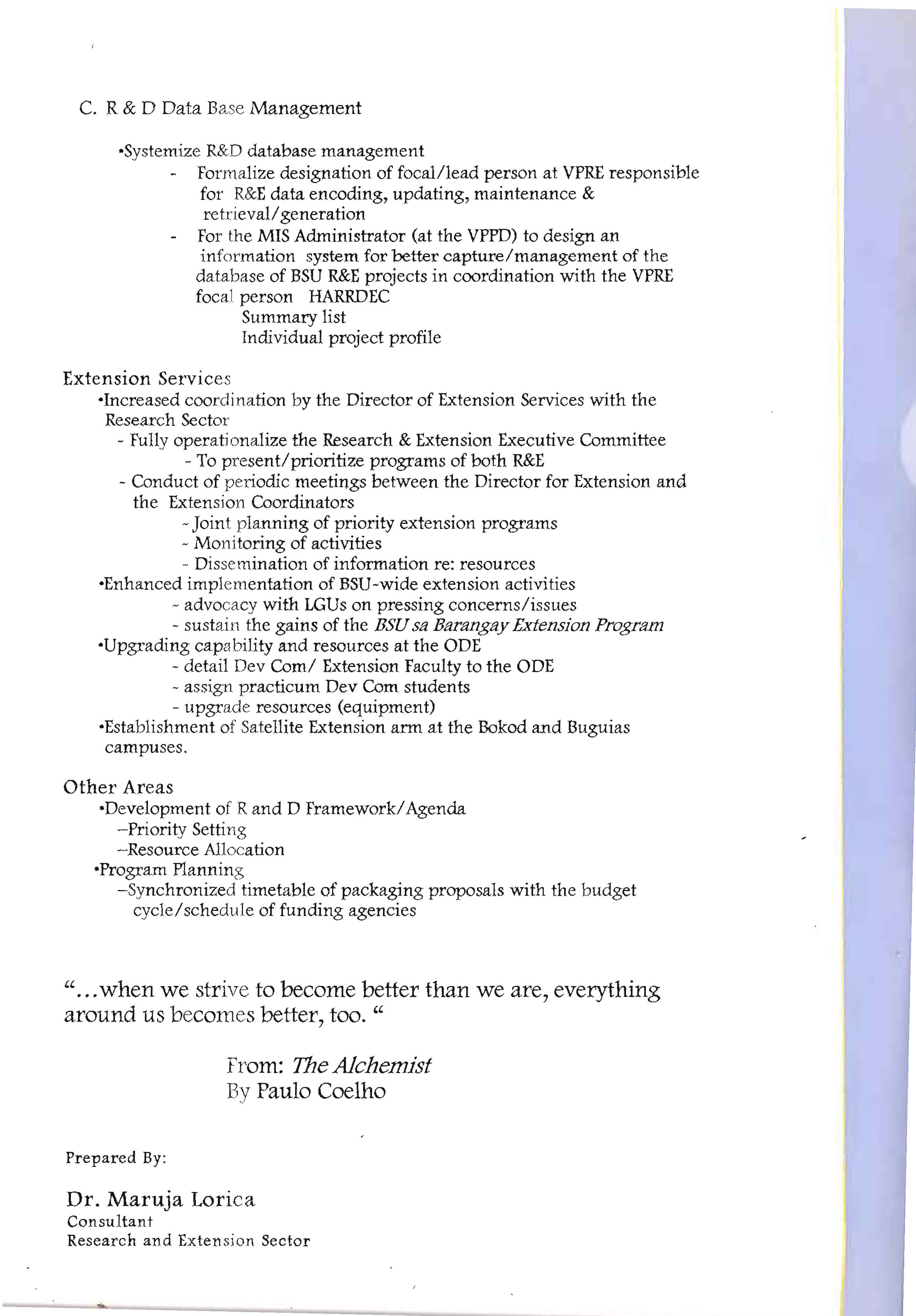
C. R&D Data Base Management
-Systemize R&D database management
Forma.lize designation of focal/lead person at VPRE responsible
for R&E data encoding, updating, maintenance &
retrieval!generation
For the MIS Administrator (at the VPPD) to design an
information system for better capture/management of the
database of BSU R&E projects in coordination with the VPRE
focal person HARRDEC
Summary list
Individual project profile
Extension Services
-Increased coordination by the Director of Extension Services with the
Research Sector
- Fully operationalize the Research & Extension Executive Committee
- To present/prioritize programs of both R&E
- Conduct of periodic meetings between the Director for Extension and
the Extension Coordinators
- Joint planning of priority extension programs
- Monitoring of activities
- Dissemination of information re: resources
-Enhanced implementation of BSU-wide extension activities
- advocacy with LGtJs on pressing concernslissues
- sustain the gains of the BSU sa Barangay Extension Program
-Upgrading capability and resources at the ODE
- detail Dev Com/ Extension Faculty to the ODE
- assign practicum Dev Com students
- upgrade resources (equipment)
-Establishment of Satellite Extension arm at the Bakod and Buguias
campuses.
Other Areas
-Development of Rand D Framework/Agenda
-Priority Setting
-Resource Allocation
-Program Planning
-Synchronized timetable of packaging proposals with the budget
cycle/schedule of funding agencies
" ... when we strive to become better than we are, everything
around us becomes better, too. "
From: The Alchemist
By Paulo Coelho
Prepared By:
Dr. Maruja Lorica
Consultant
Research and Extension Sector
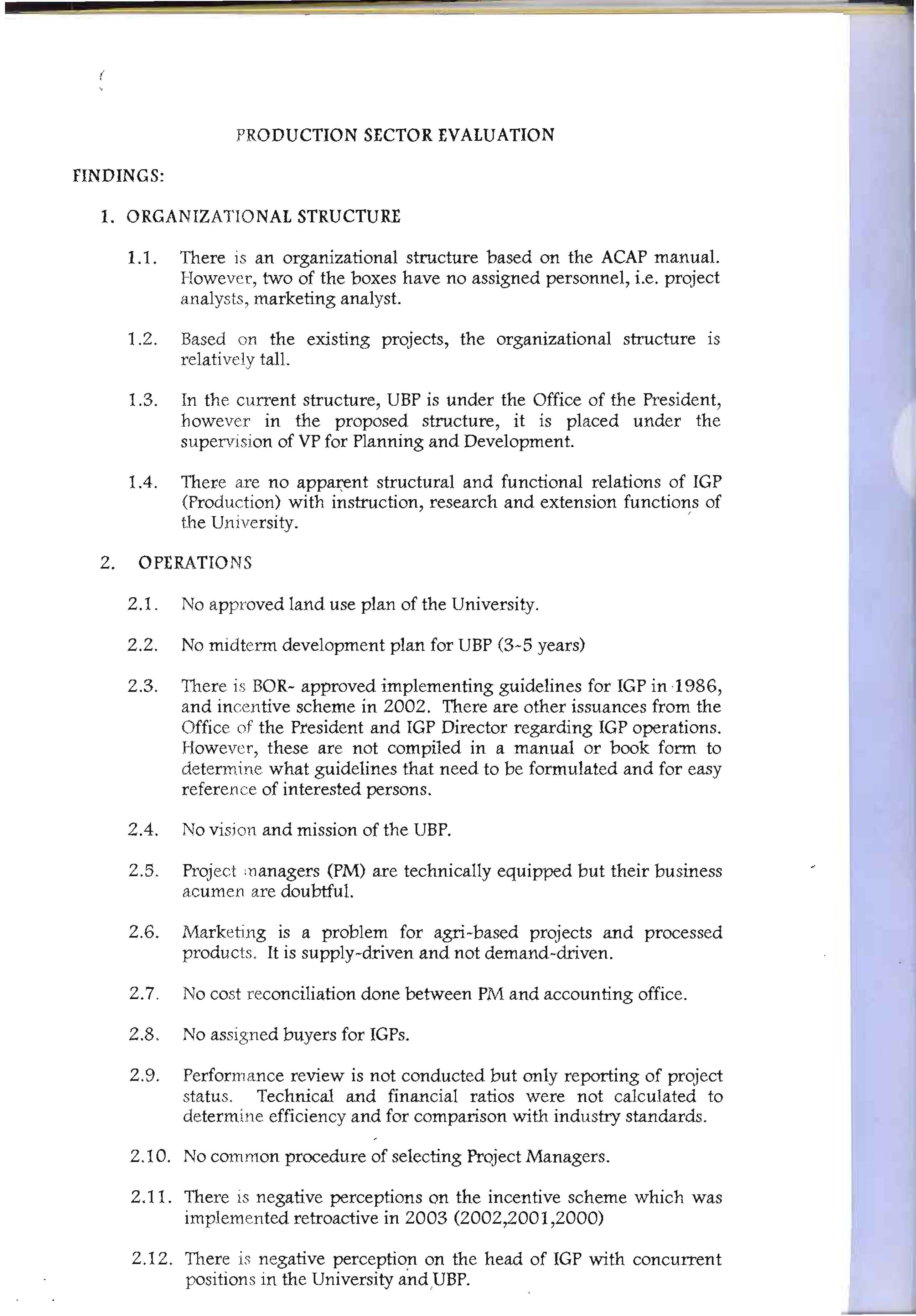
-
-
-
- - -
(
PRODUCTION SECTOR EVALUATION
FINDINGS:
1. ORGANIZATIONAL STRUCTURE
1.1. There is an organizational structure based on the ACAP manual.
However, two of the boxes have no assigned personnel, i.e. project
analysts, marketing analyst.
1.2. Based on the existing projects, the organizational structure is
relatively talL
1.3. In the current structure, UBP is under the Office of the President,
however in the proposed structure, it is placed under the
supervision of VP for Planning and Development.
1.4. There are no appar:ent structural and functional relations of IGP
(Production) with instruction, research and extension functions of
the University.
'
2.
OPERATIONS
2.1. No approved land use plan of the University.
2.2. No midtenn development plan for UBP (3-5 years)
2.3. There is BOR- approved implementing guidelines for IGP in '1986,
and incentive scheme in 2002. There are other issuances from the
Office of the President and IGP Director regarding IGP operations.
However, these are not compiled in a manual or book fonn to
determine what guidelines that need to be formulated and for easy
reference of interested persons.
2.4. No vision and mission of the UBP.
2.5. Project :nanagers (PM) are technically equipped but their business
a.cumen are doubtful.
2.6. Marketing is a problem for agri-based projects and processed
products. It is supply-driven and not demand-driven.
2.7. No cost reconciliation done between PM and accounting office.
2.8, No assigned buyers for IGPs.
2.9. Performance review is not conducted but only reporting of project
status.
Technical and financial ratios were not calculated to
determine efficiency and for comparison with industry standards.
2.10. No common procedure of selecting Project Managers.
2.11. There is negative perceptions on the incentive scheme which was
implemented retroactive in 2003 (2002,2001,2000)
2.12. There is negative perception on the head of IGP with concurrent
positions in the University and,UBP.
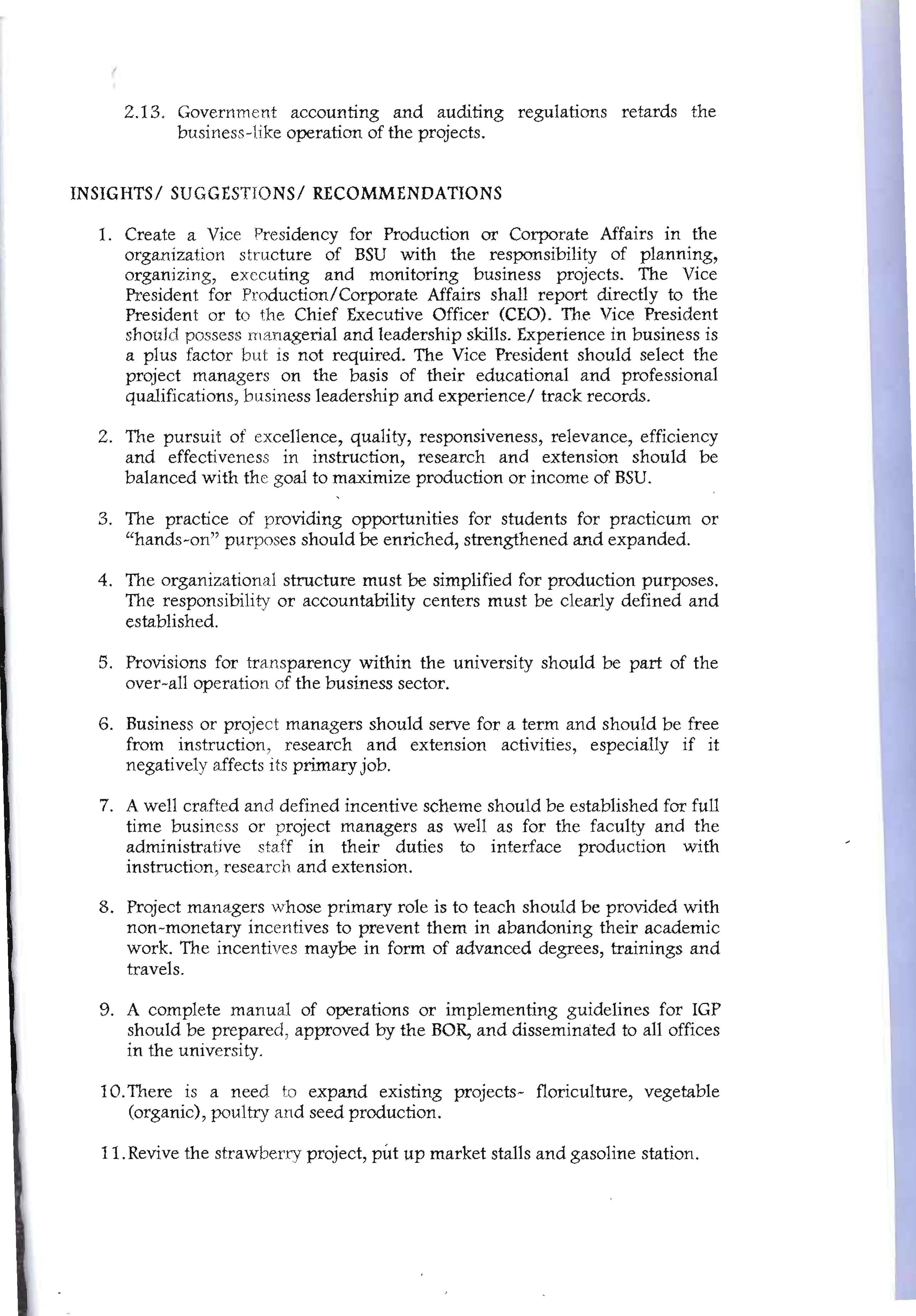
2.13. Government accounting and auditing regulations retards the
business-like operation of the projects.
INSIGHTS/ SUGGESTIONS/ RECOMMENDATIONS
1. Create a Vice Presidency for Production or Corporate Mfairs in the
organization structure of BSU with the responsibility of planning,
organizing, execu.ting and monitoring business projects. The Vice
President for Production/Corporate Mfairs shall report directly to the
President or to the Chief Executive Officer (CEO). Th.e Vice President
shoUld possess rnanagerial and leadership skills. Experience in business is
a plus factor but is not required. The Vice President should select the
project managers on the basis of their educational and professional
qualifications, business leadership and experience/ track records.
2. The pursuit of excellence, quality, responsiveness, relevance, efficiency
and effectiveness in instruction, research and extension should be
balanced with the goal to maximize production or income of BSU.
3. The practice of providing opportunities for students for practicum or
"hands-on" purposes should be enriched, strengthened and expanded.
4. The organizational structure must be simplified for production purposes.
The responsibility or accountability centers must be clearly defined and
established.
5. Provisions for transparency within the university should be part of the
over-all operation of the business sector.
6. Business or prqject managers should serve for a term and should be free
from instruction, research and extension activities, especially if it
negatively affects its primary job.
7. A well crafted and defined incentive scheme should be established for full
time business or project managers as well as for the faculty and the
administrative staff in their duties to interface production with
instruction, research and extension.
8. Project managers whose primary role is to teach should be provided with
non-monetary incentives to prevent them in abandoning their academic
work. The incentives maybe in form of advanced degrees, trainings and
travels.
9. A complete manual of operations or implementing guidelines for IGP
should be prepared, approved by the BOR, and disseminated to all offices
in the university.
IO.There is a need to expand eXlshng projects- floriculture, vegetable
(organic), poultry and seed production.
I 1. Revive the strawberry project, put up market stalls and gasoline station.

OVER-ALL OPERATIONS OF BSU
1. The university should go corporate governance or pursue good
governance. This simply means that the university should adapt or
implement the "best practices" of a regular business corporation e.g. the
importance of the functions of the Board of Directors, transparency,
accountability, efficiency, and effectiveness in operations.
2. The management should explore the possibility of annually adjusting or
increasing tuition fee and other charges for incoming freshmen only. In
doing so, the university should have a survey of existing fee levels being
charged by universities and colleges in the area, both public and private.
3. The massive and complex plant facilities of the university requires a
maintenance, upkeeping and upgrading office headed by professional
engineers with adequate skilled manpower support.
4. Strengthen the BSU Foundation that serves as the holding company for
the different subsidiary corporations. It operates as a regular corporation
primarily put up to earn for the stockholders (composed of university
faculty and staff, alumni and friends of BSU)
5. There is an urgent need to develop BSU as tourist destination aild will be
known for its year round production of flowers, vegetables, strawberry,
fruits and other high value commercial crops unique in the uplands.
Evaluators:
Dr. Ernesto De Chavez
Dr. Eduardo G. Marzan Jr.